Developer Experience != Developer Productivity
A presentation at KCDC 2025 in in Kansas City, MO, USA by Jeremy Meiss
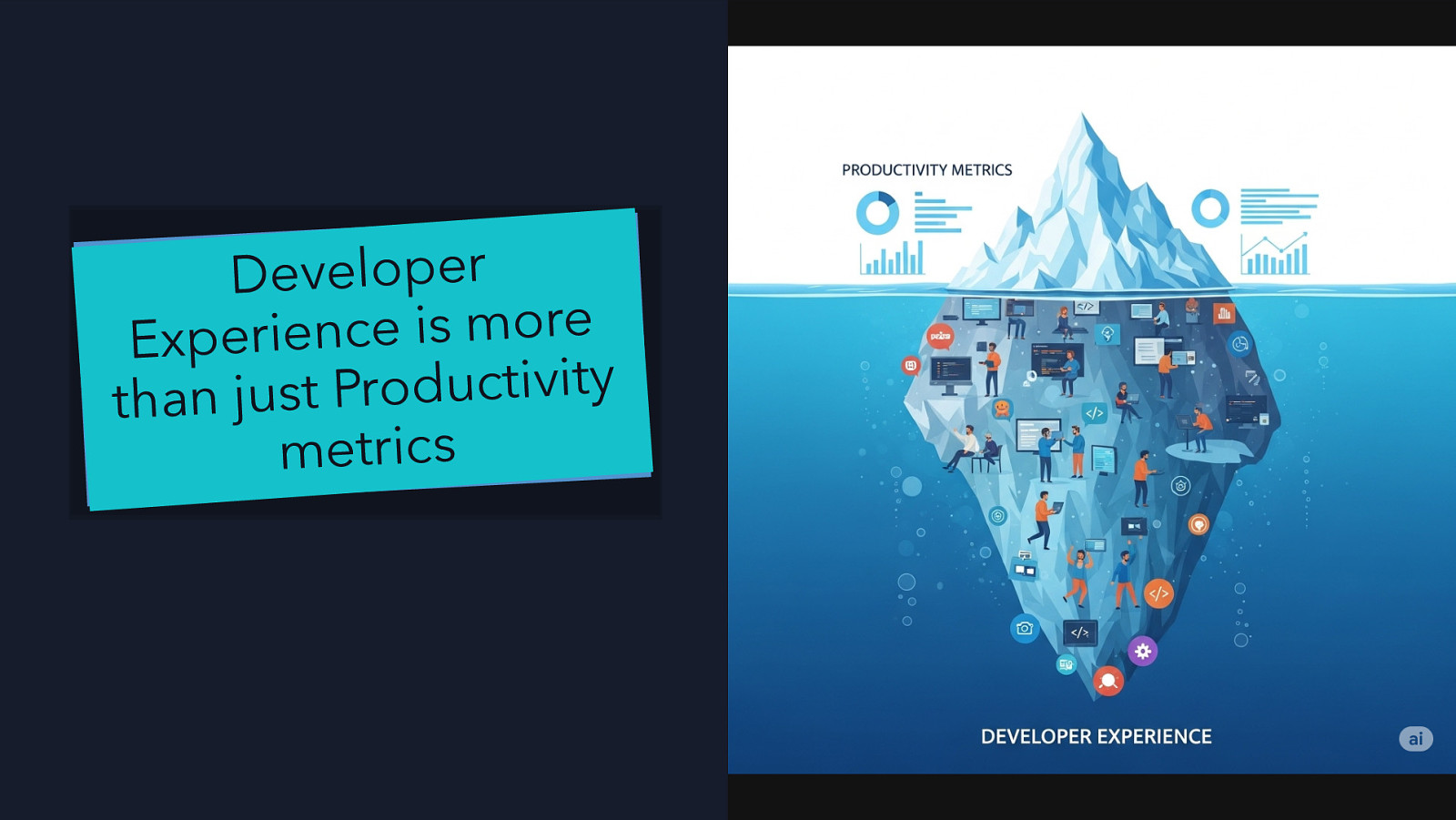
Developer Experience is more than just Productivity metrics
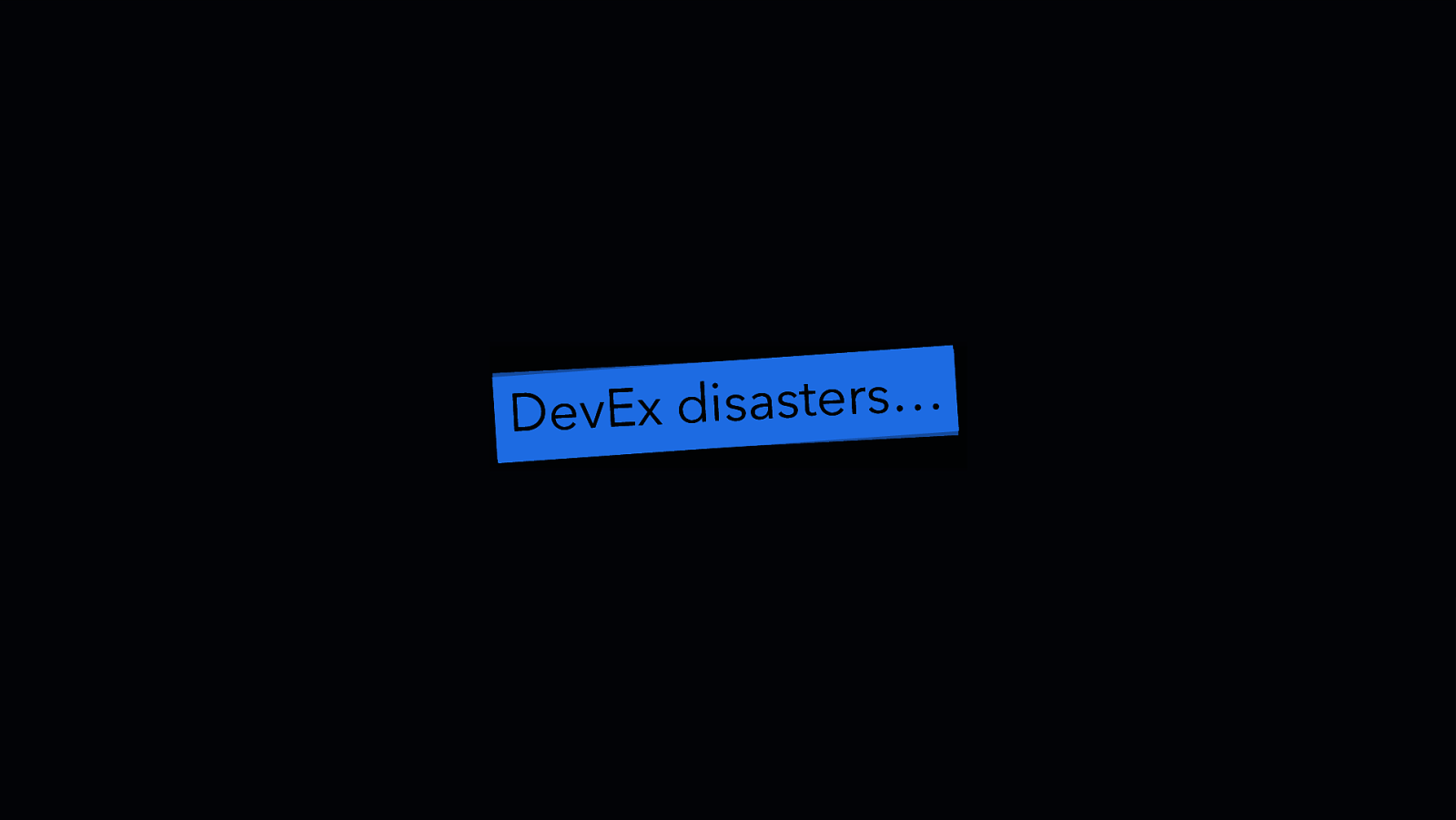
DevEx disasters…
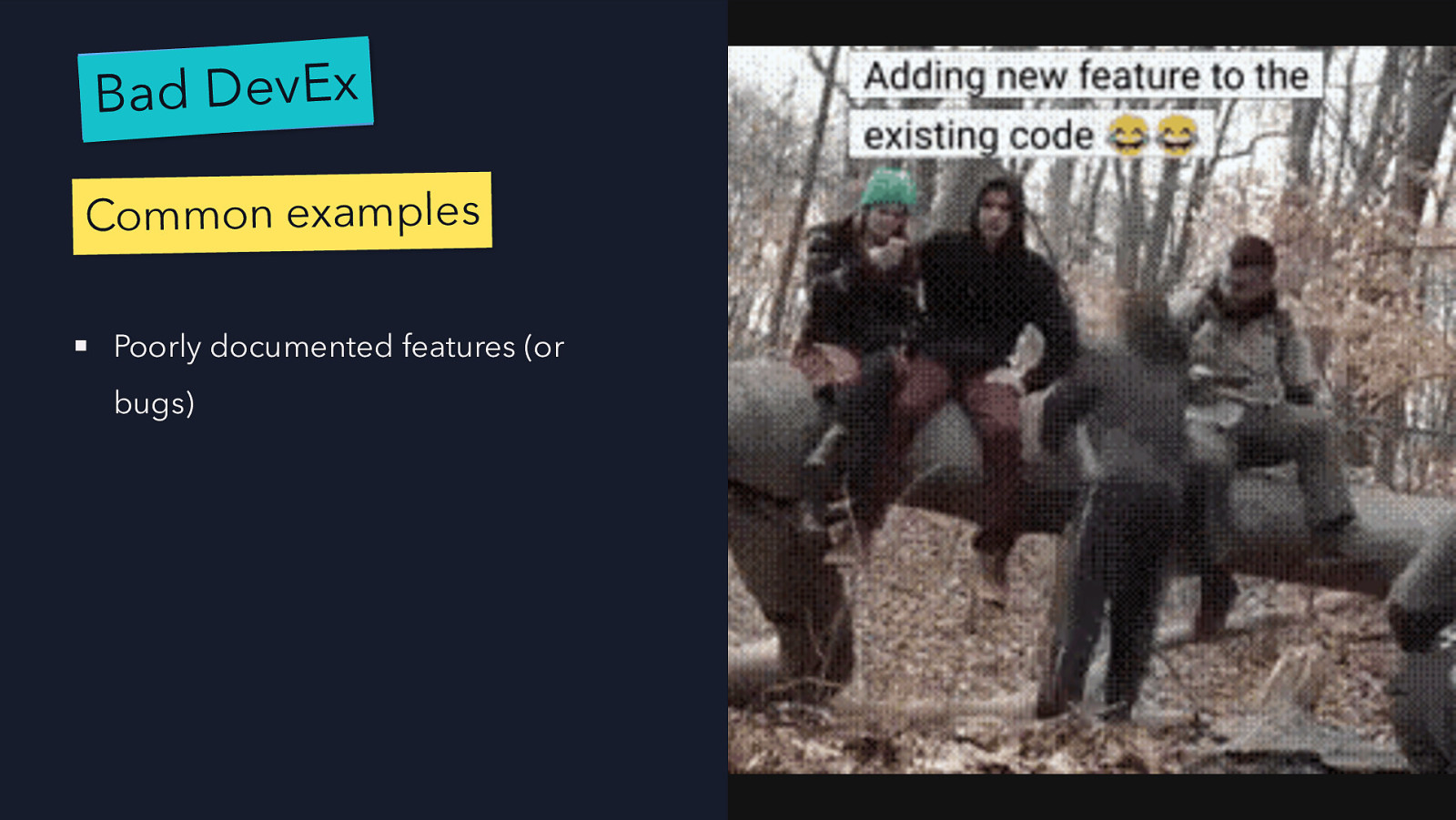
Bad DevEx Common examples Poorly documented features (or bugs)
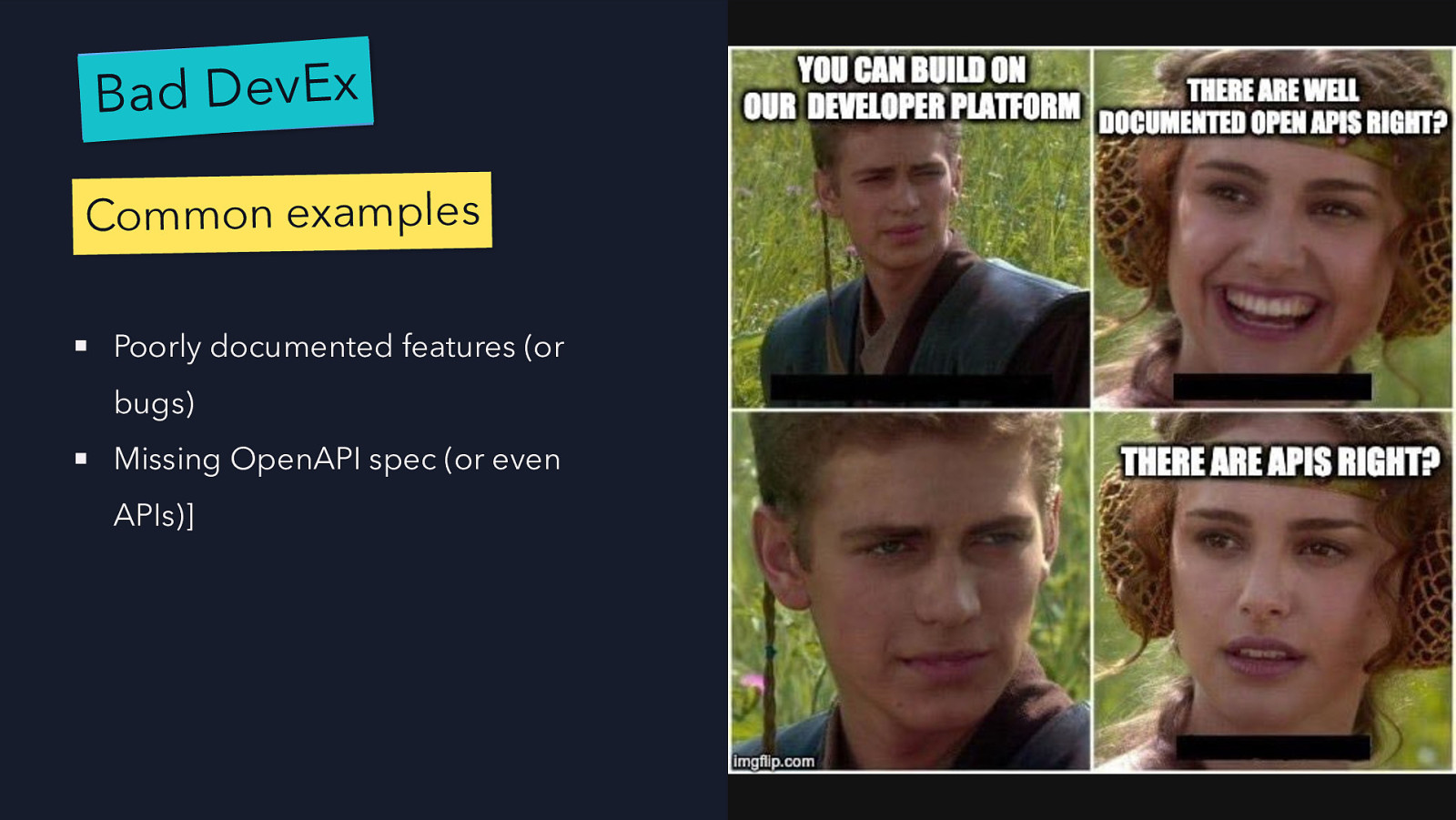
Bad DevEx Common examples Poorly documented features (or bugs) Missing OpenAPI spec (or even APIs)]
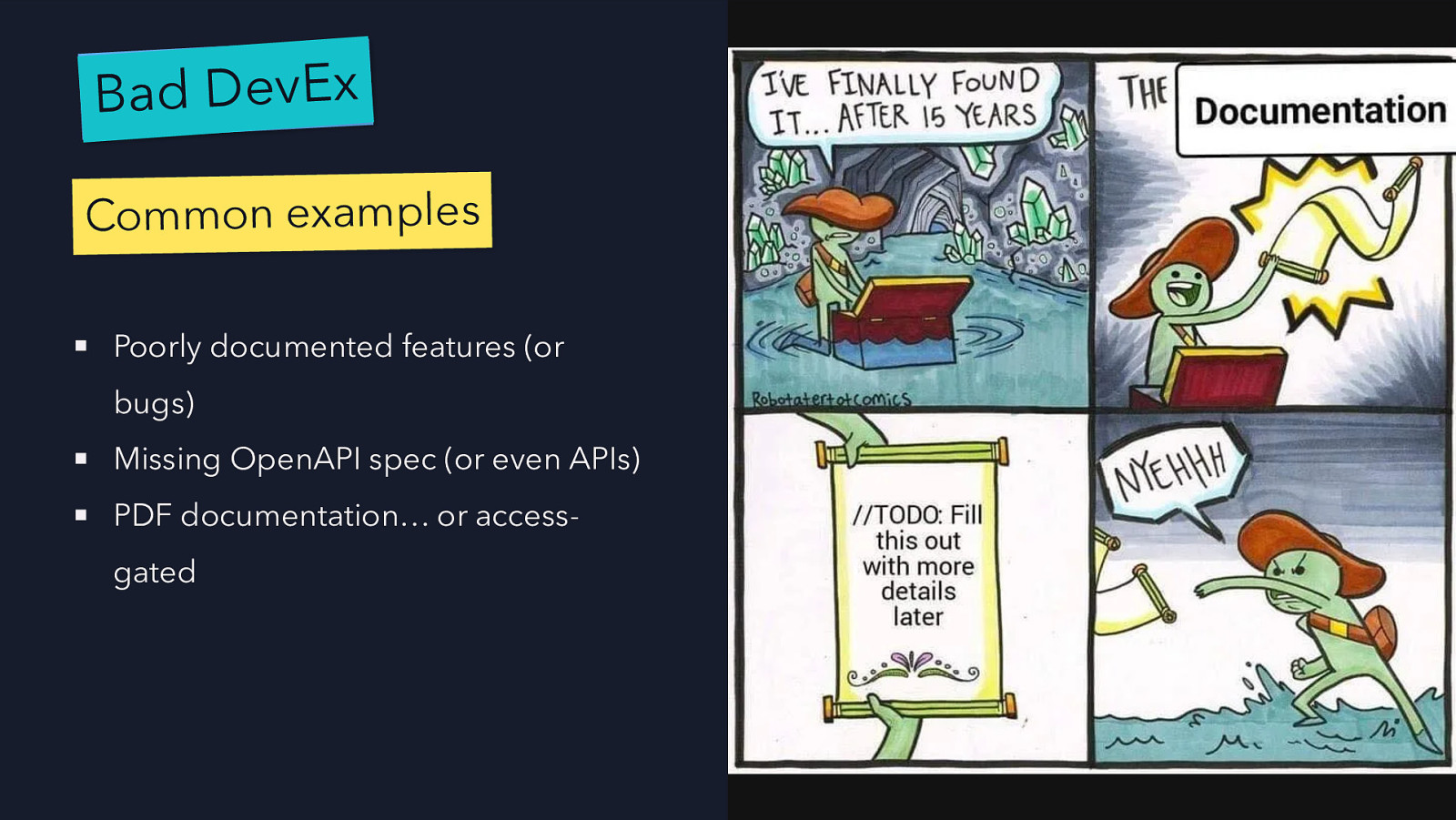
Bad DevEx Common examples Poorly documented features (or bugs) Missing OpenAPI spec (or even APIs) PDF documentation… or accessgated
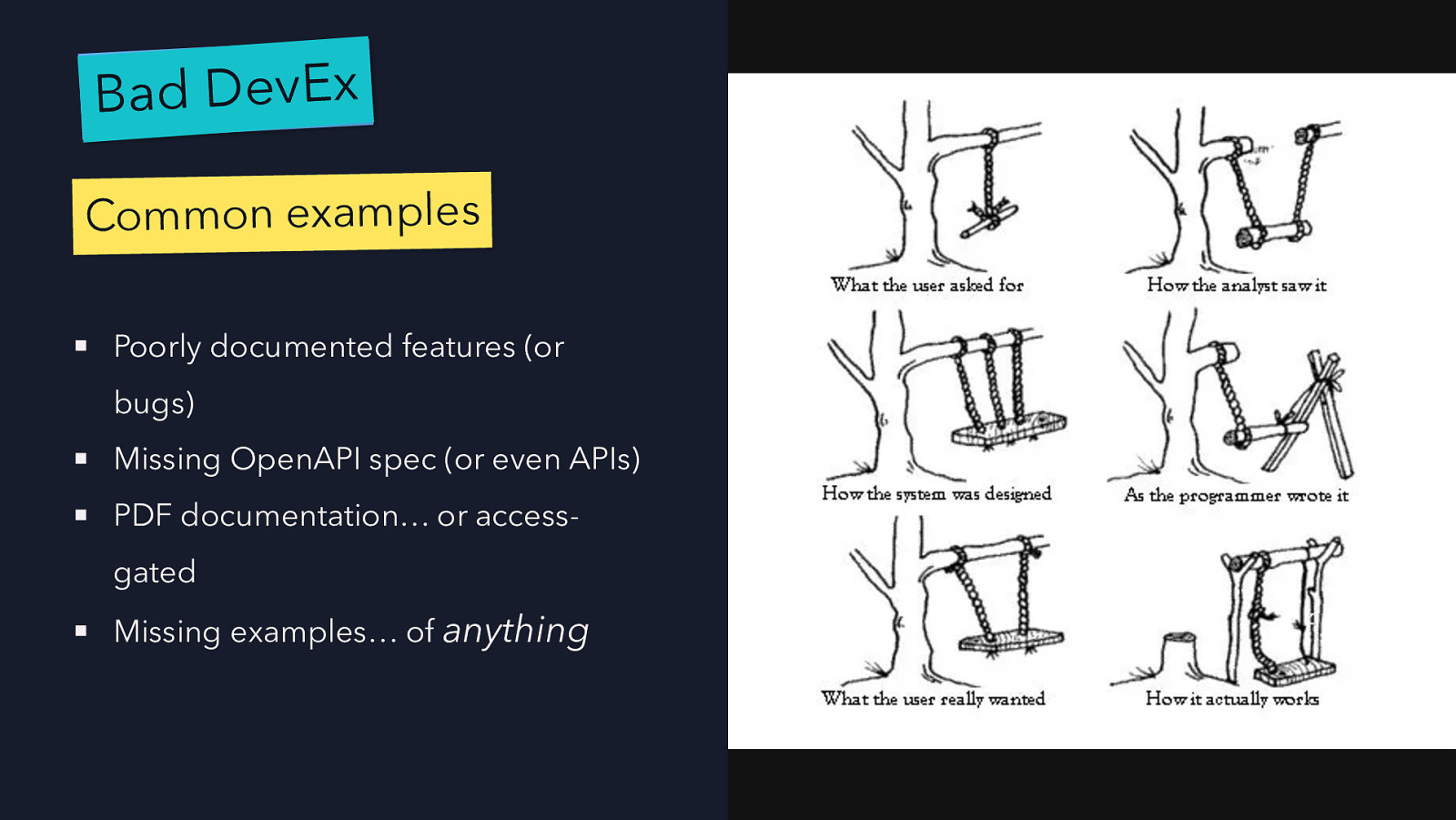
Bad DevEx Common examples Poorly documented features (or bugs) Missing OpenAPI spec (or even APIs) PDF documentation… or accessgated Missing examples… of anything
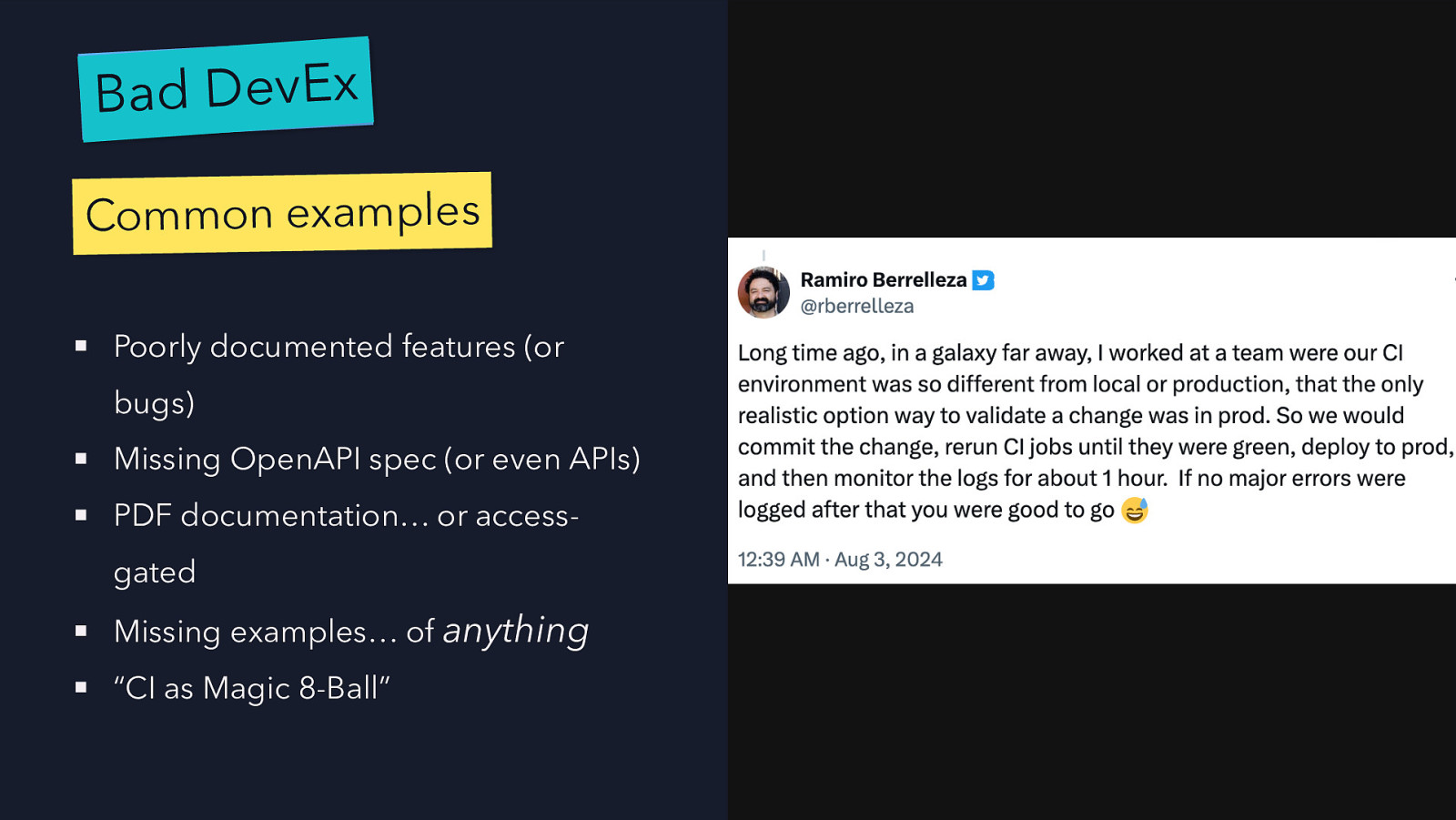
Bad DevEx Common examples Poorly documented features (or bugs) Missing OpenAPI spec (or even APIs) PDF documentation… or accessgated Missing examples… of anything “CI as Magic 8-Ball”
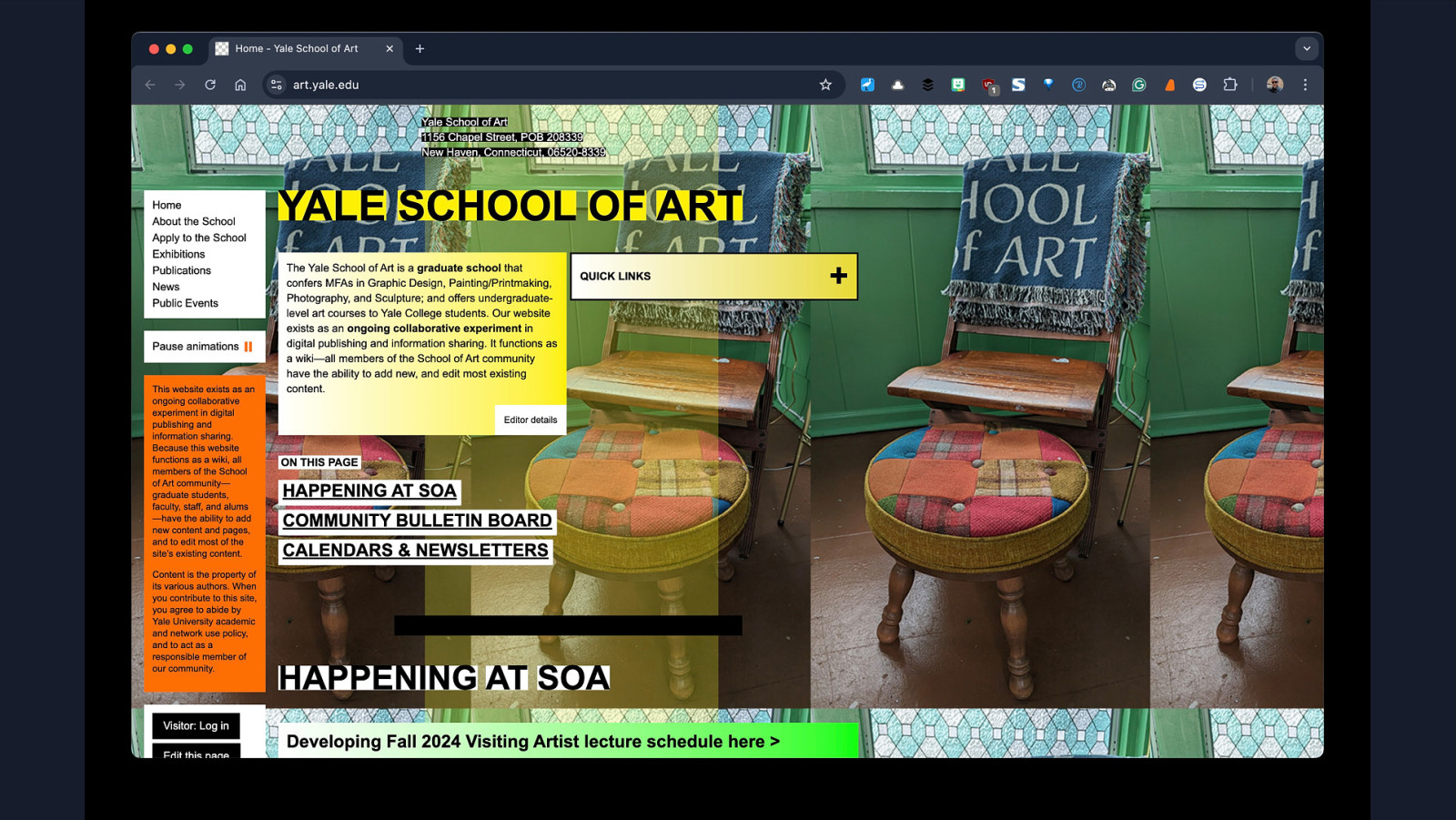


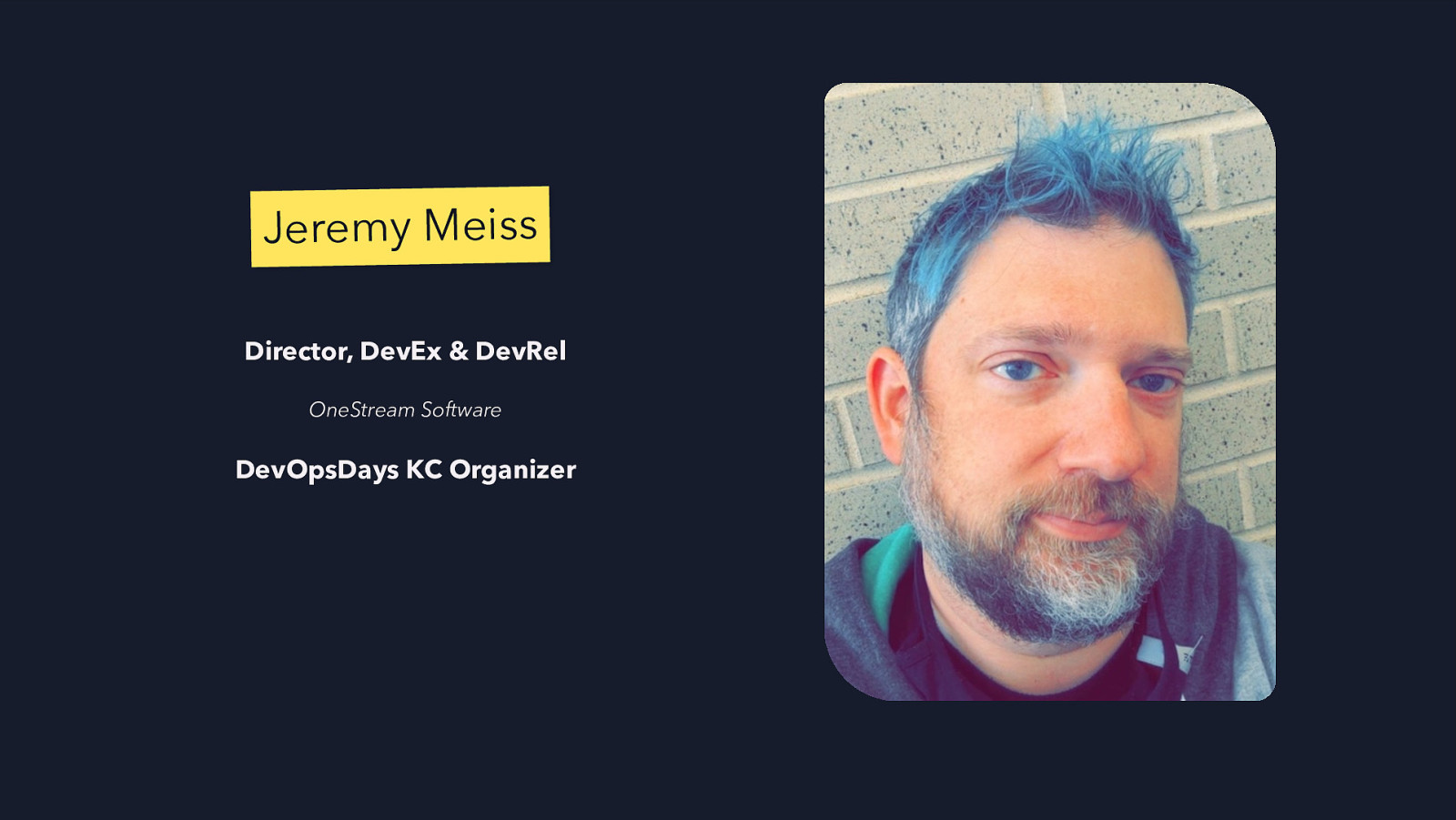
Jeremy Meiss Director, DevEx & DevRel OneStream Software DevOpsDays KC Organizer
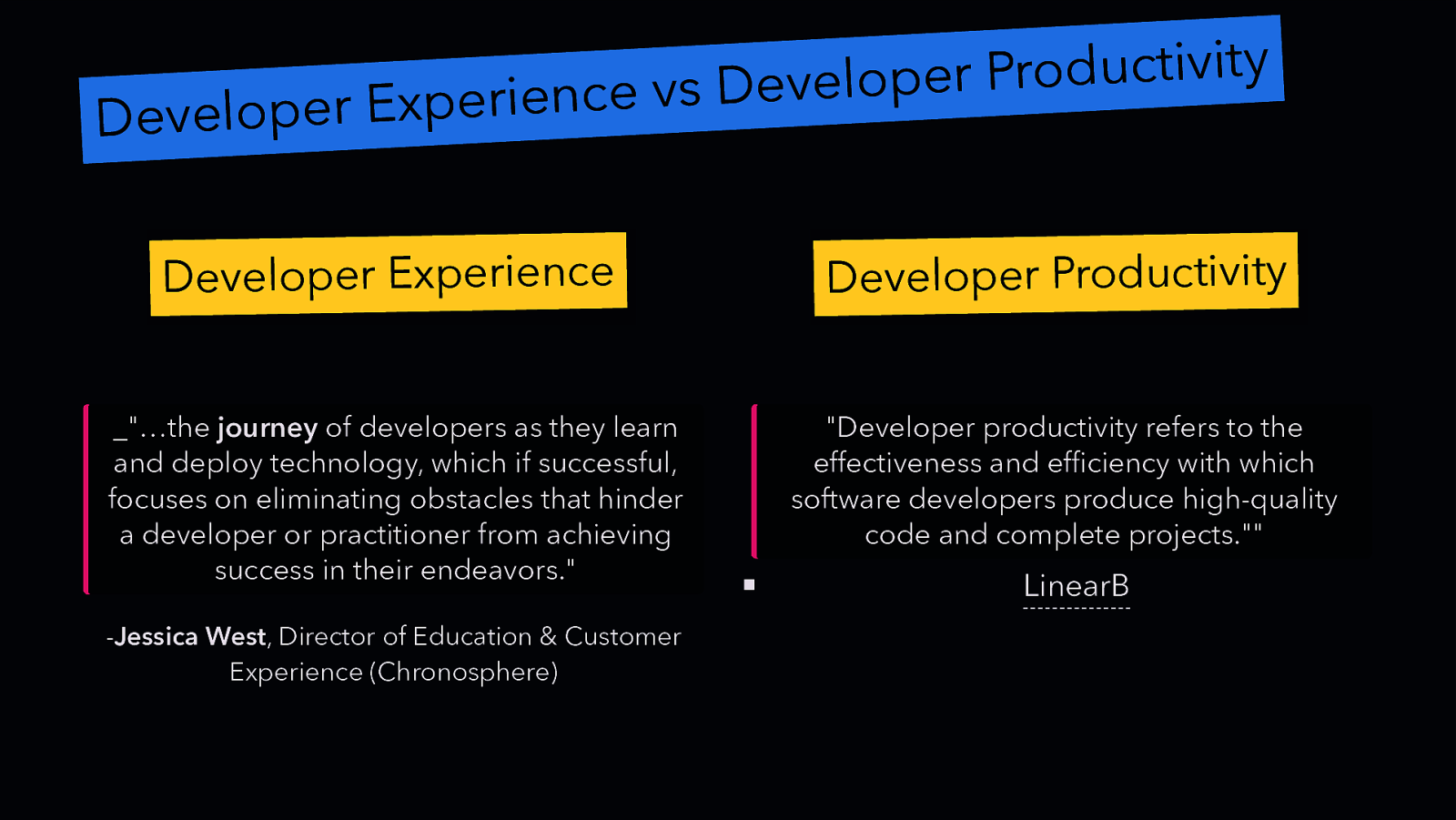
y it v ti c u d ro P r e p lo e v e e vs D c n ie r e p x E r e p lo e v e D Developer Experience Developer Productivity _”…the journey of developers as they learn and deploy technology, which if successful, focuses on eliminating obstacles that hinder a developer or practitioner from achieving success in their endeavors.” “Developer productivity refers to the effectiveness and efficiency with which software developers produce high-quality code and complete projects.”” -Jessica West, Director of Education & Customer Experience (Chronosphere) LinearB
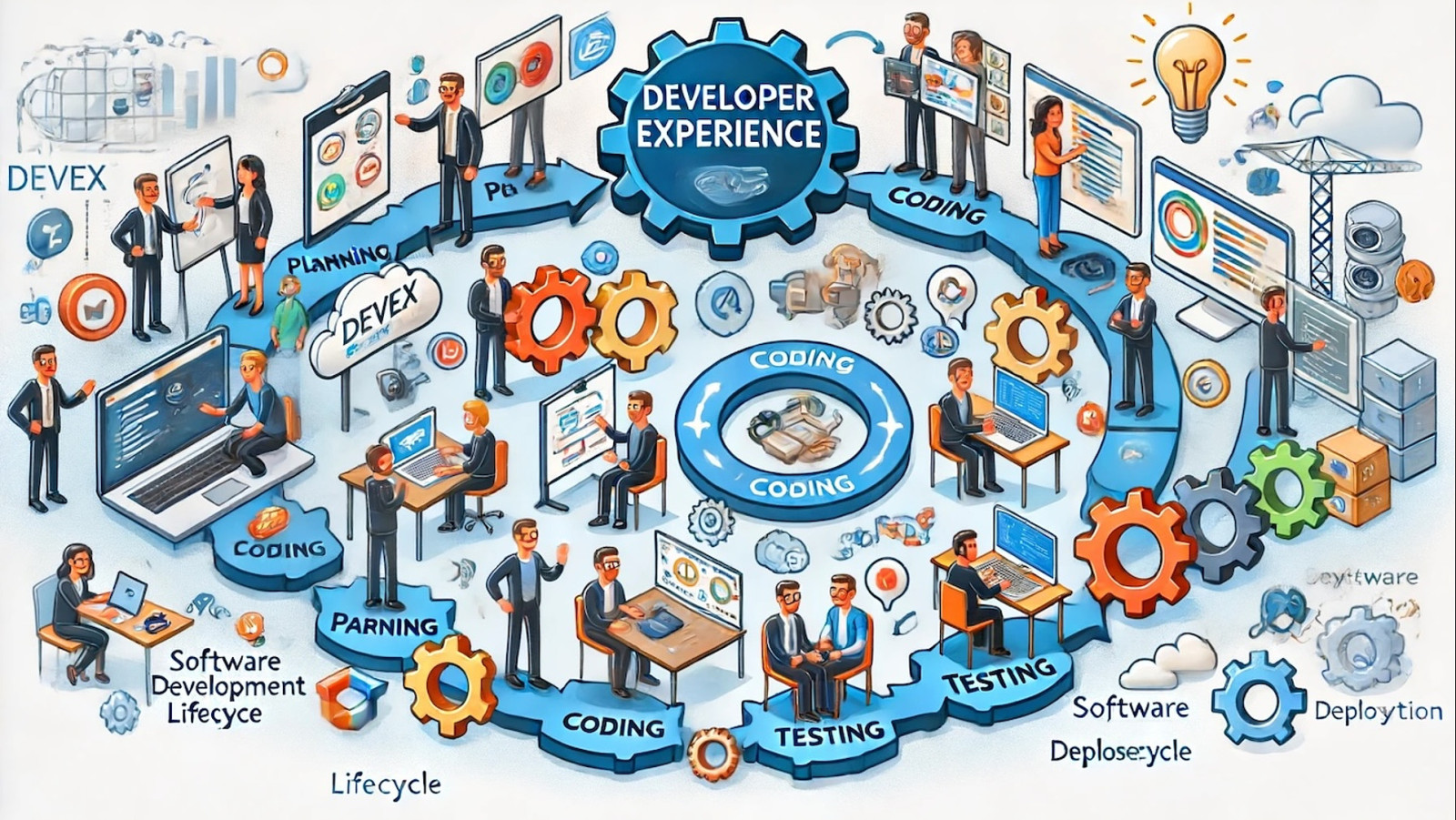
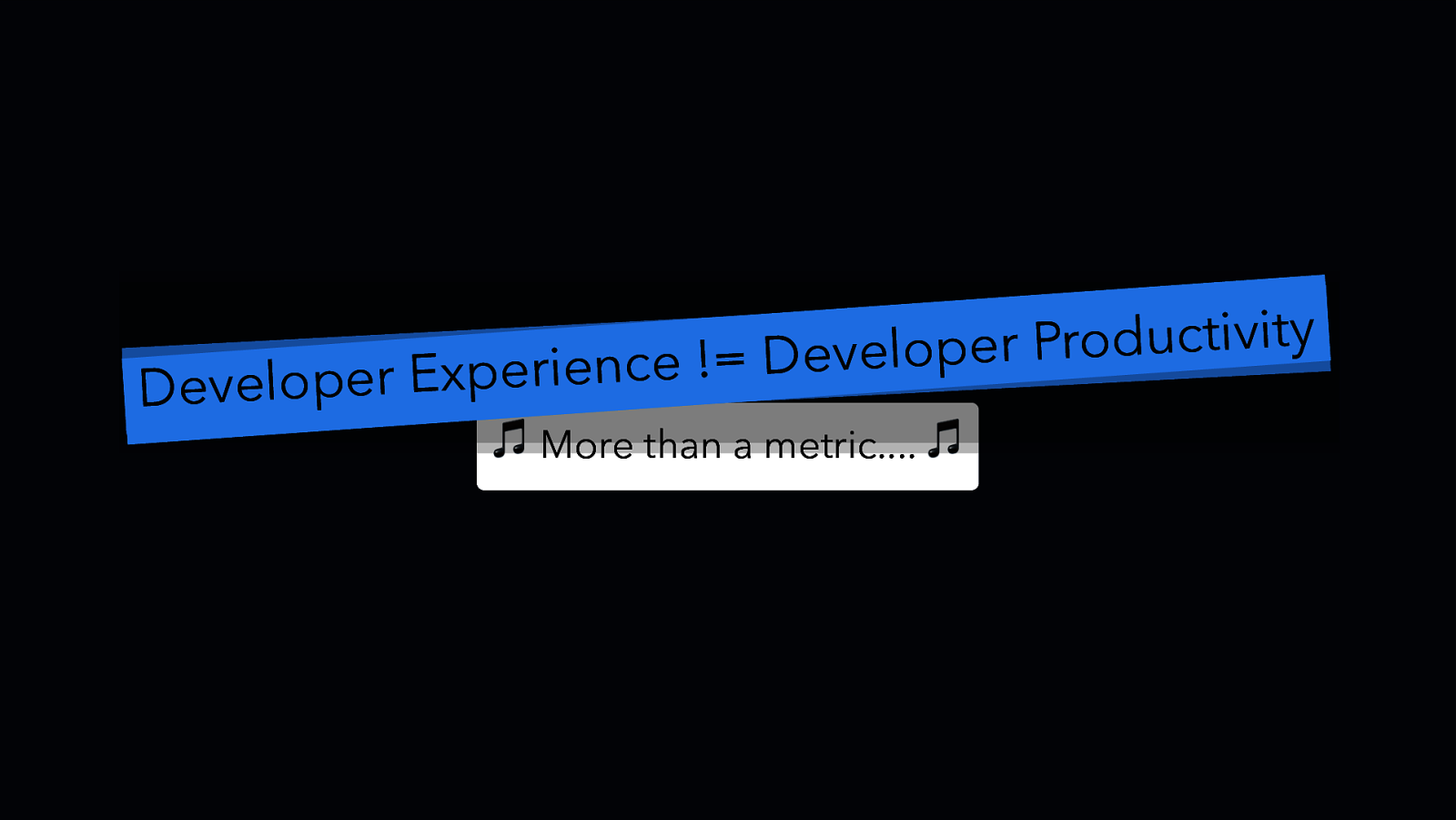
Develo y it v ti c u d ro P r e p lo e v e per Experience != D More than a metric….
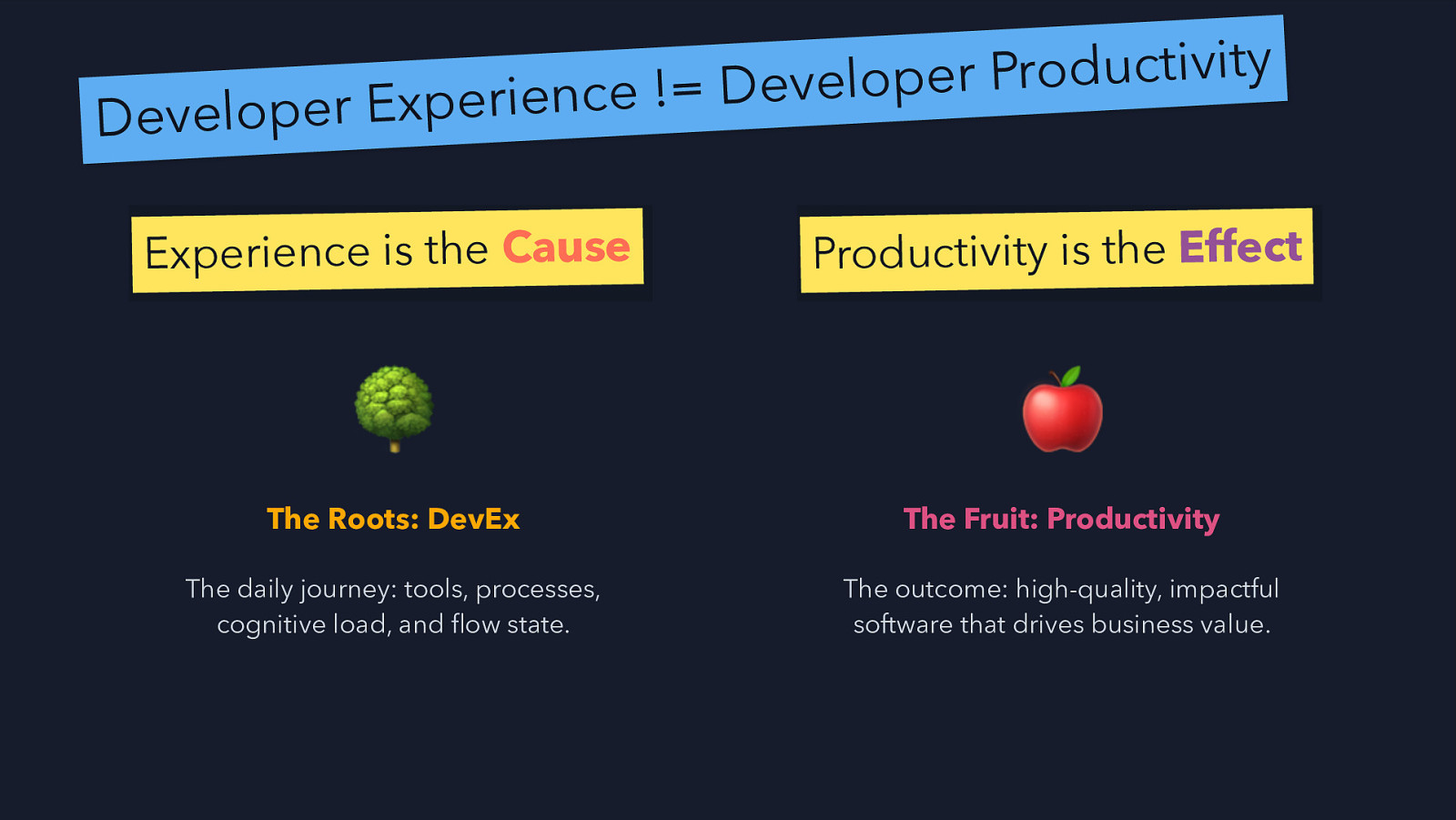
y it v ti c u d ro P r e p lo e v e e != D c n ie r e p x E r e p lo e v e D Experience is the Cause Productivity is the Effect The Roots: DevEx The Fruit: Productivity The daily journey: tools, processes, cognitive load, and flow state. The outcome: high-quality, impactful software that drives business value.
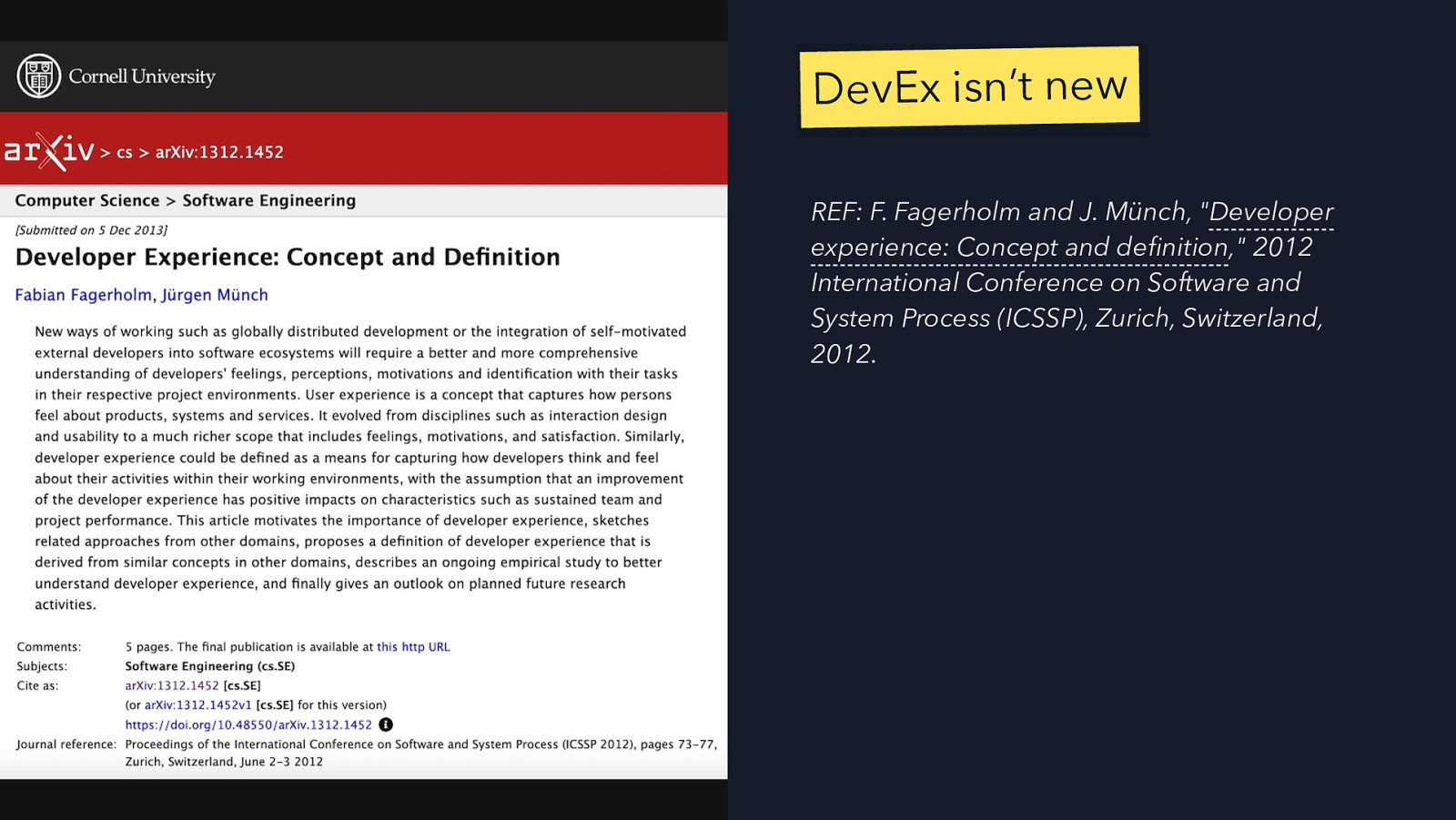
DevEx isn’t new REF: F. Fagerholm and J. Münch, “Developer experience: Concept and definition,” 2012 International Conference on Software and System Process (ICSSP), Zurich, Switzerland, 2012.
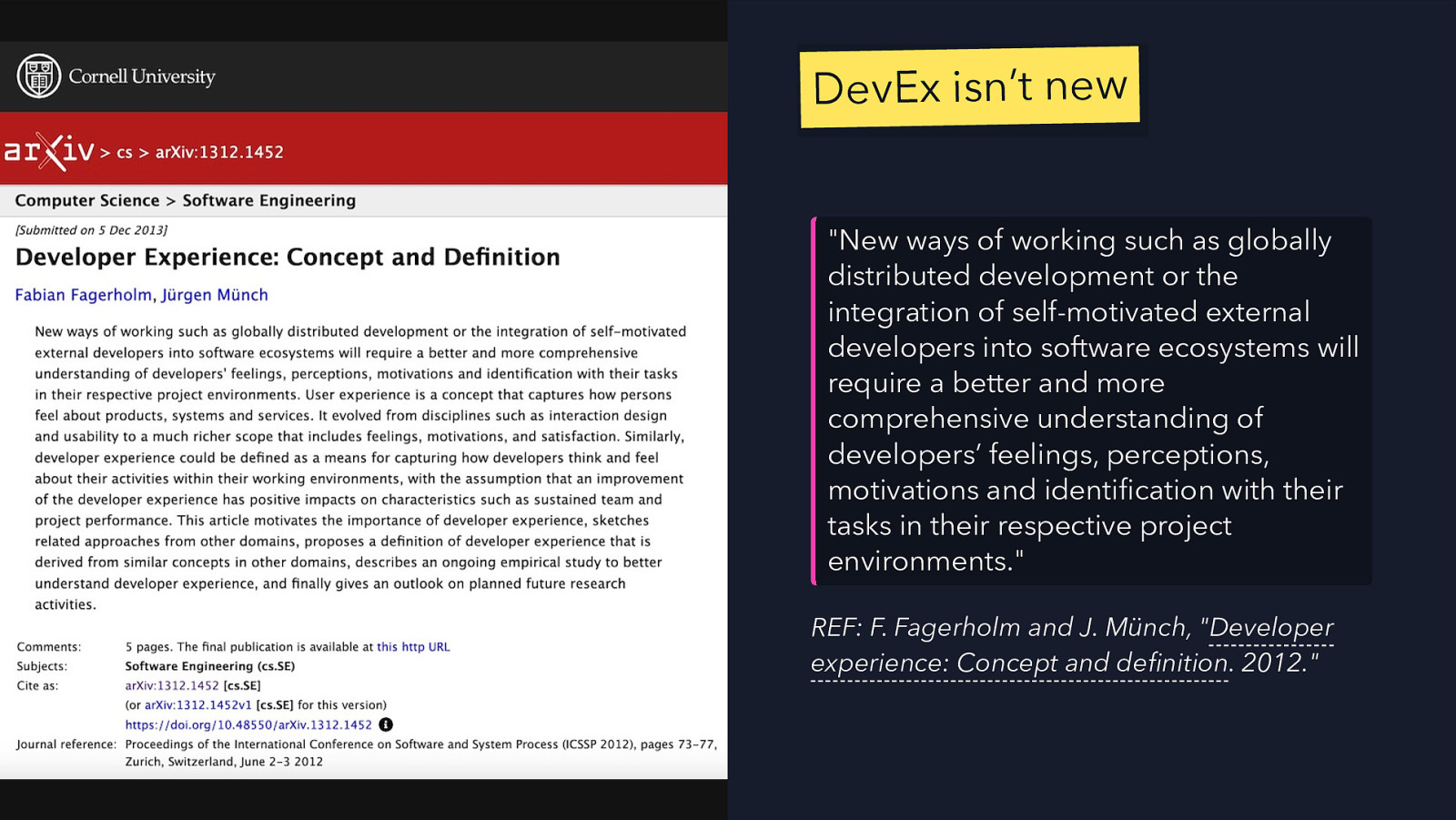
DevEx isn’t new “New ways of working such as globally distributed development or the integration of self-motivated external developers into software ecosystems will require a better and more comprehensive understanding of developers’ feelings, perceptions, motivations and identification with their tasks in their respective project environments.” REF: F. Fagerholm and J. Münch, “Developer experience: Concept and definition. 2012.”
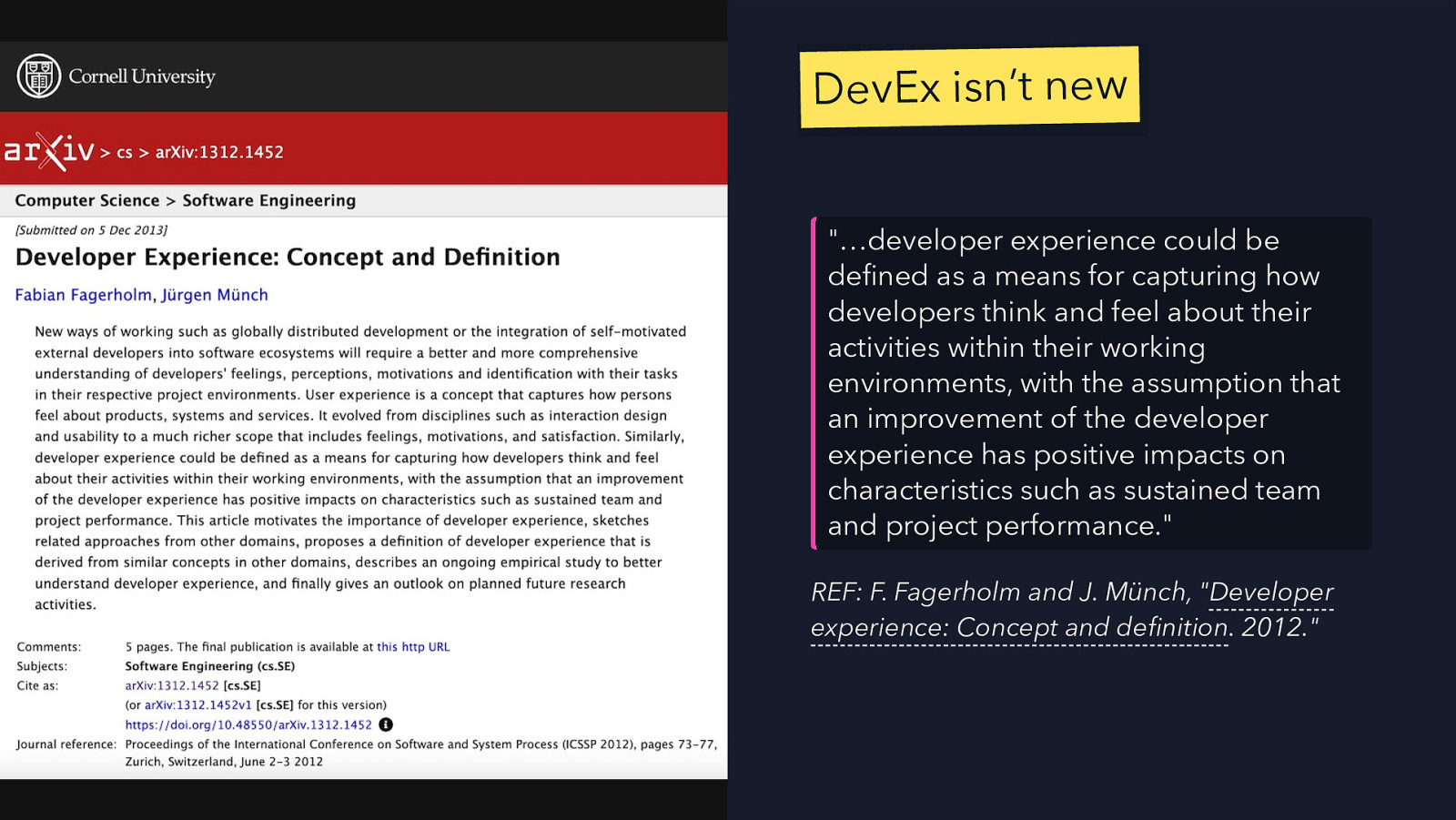
DevEx isn’t new “…developer experience could be defined as a means for capturing how developers think and feel about their activities within their working environments, with the assumption that an improvement of the developer experience has positive impacts on characteristics such as sustained team and project performance.” REF: F. Fagerholm and J. Münch, “Developer experience: Concept and definition. 2012.”
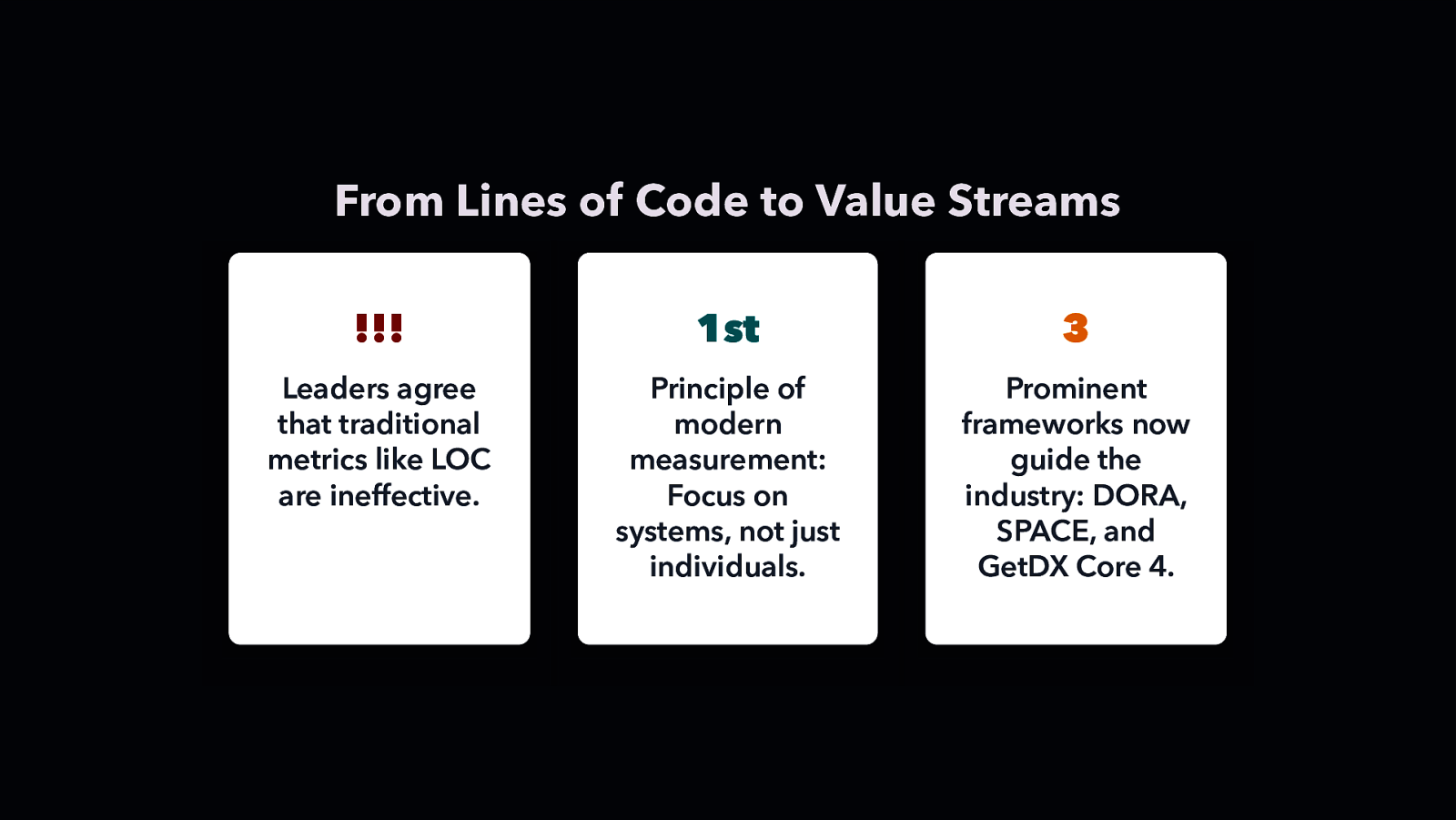
From Lines of Code to Value Streams !!! 1st 3 Leaders agree that traditional metrics like LOC are ineffective. Principle of modern measurement: Focus on systems, not just individuals. Prominent frameworks now guide the industry: DORA, SPACE, and GetDX Core 4.
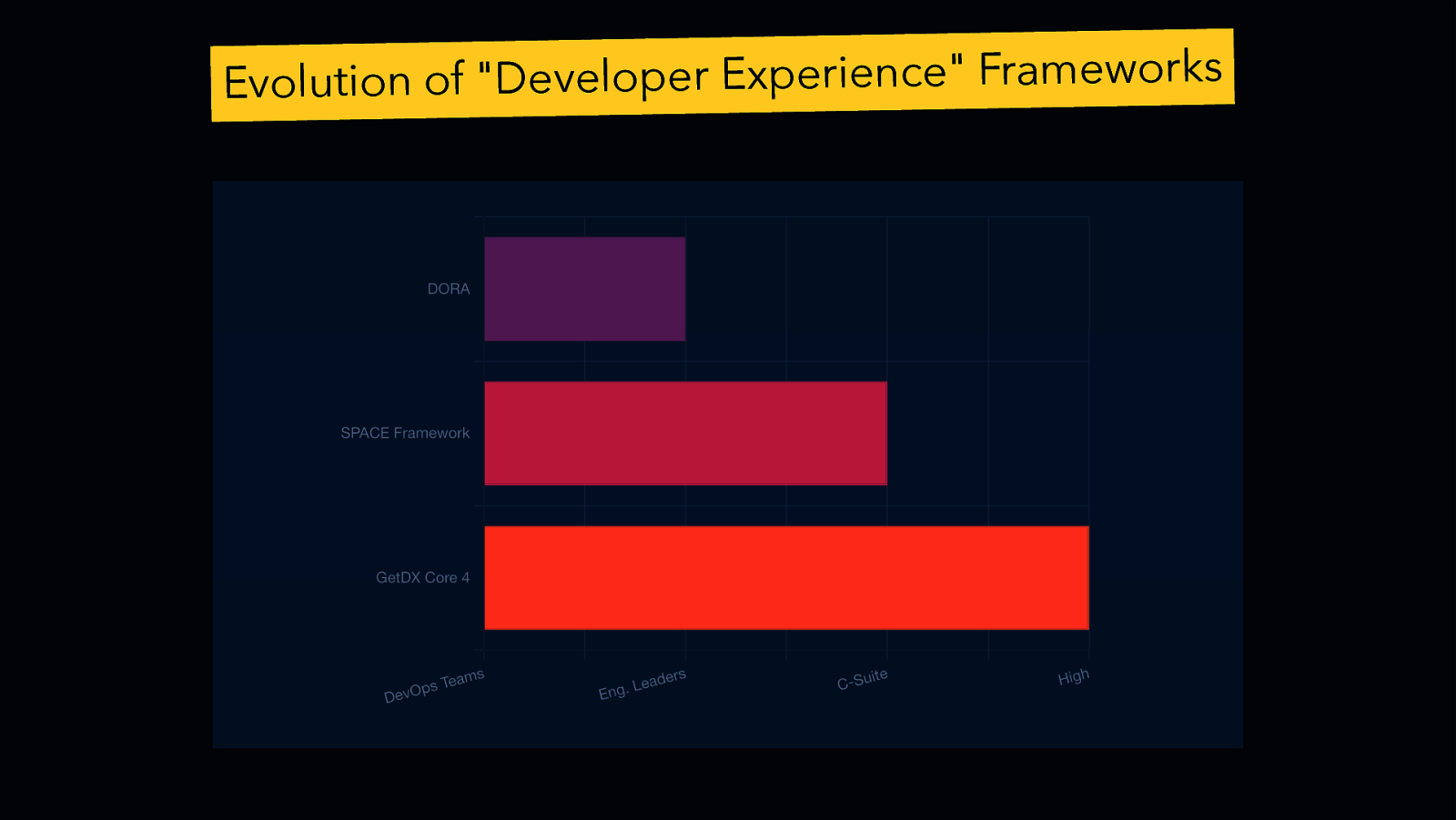
Evolution of “Developer Experience” Frameworks
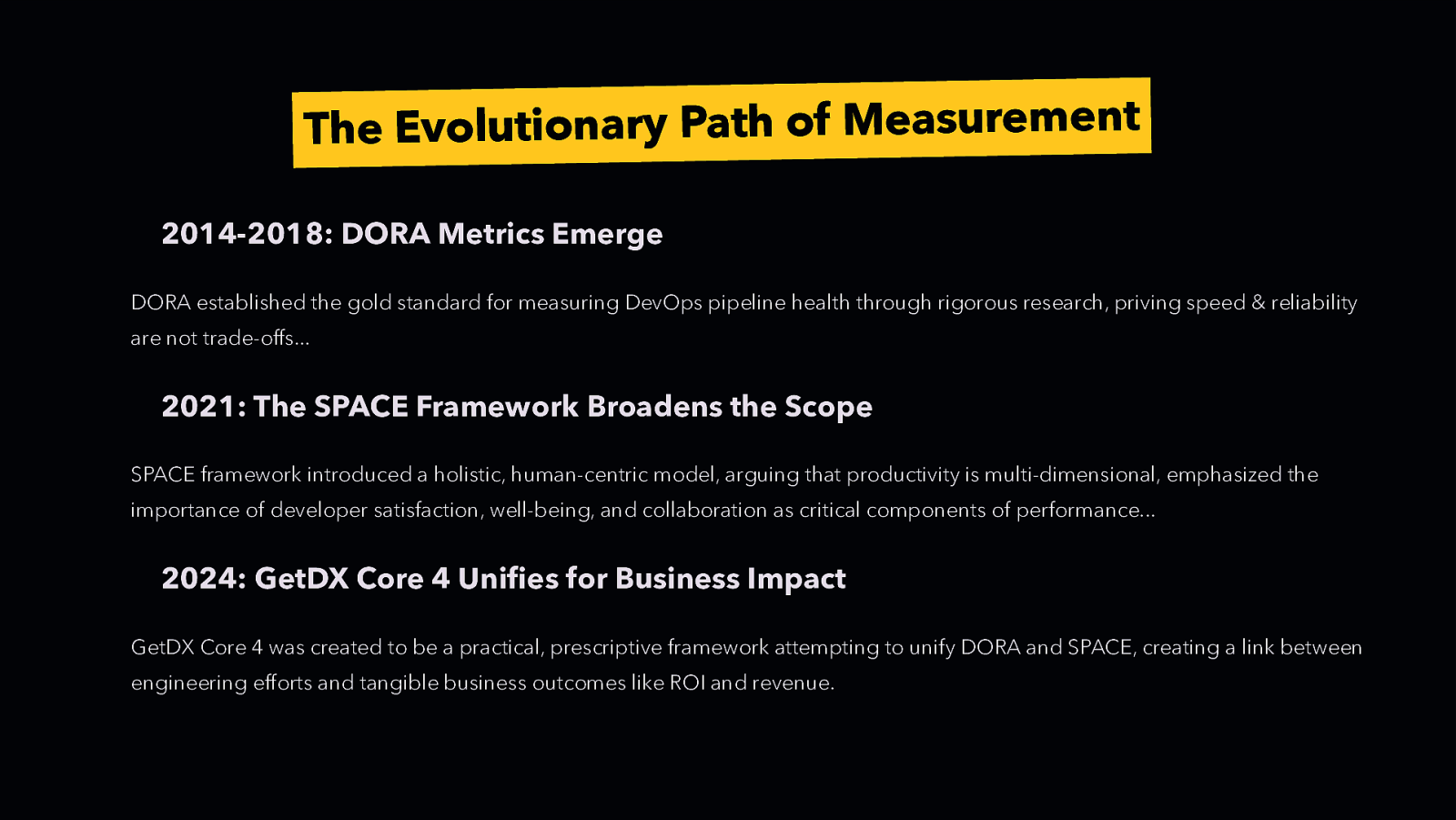
The Evolutionary Path of Measurement 2014-2018: DORA Metrics Emerge DORA established the gold standard for measuring DevOps pipeline health through rigorous research, priving speed & reliability are not trade-offs… 2021: The SPACE Framework Broadens the Scope SPACE framework introduced a holistic, human-centric model, arguing that productivity is multi-dimensional, emphasized the importance of developer satisfaction, well-being, and collaboration as critical components of performance… 2024: GetDX Core 4 Unifies for Business Impact GetDX Core 4 was created to be a practical, prescriptive framework attempting to unify DORA and SPACE, creating a link between engineering efforts and tangible business outcomes like ROI and revenue.
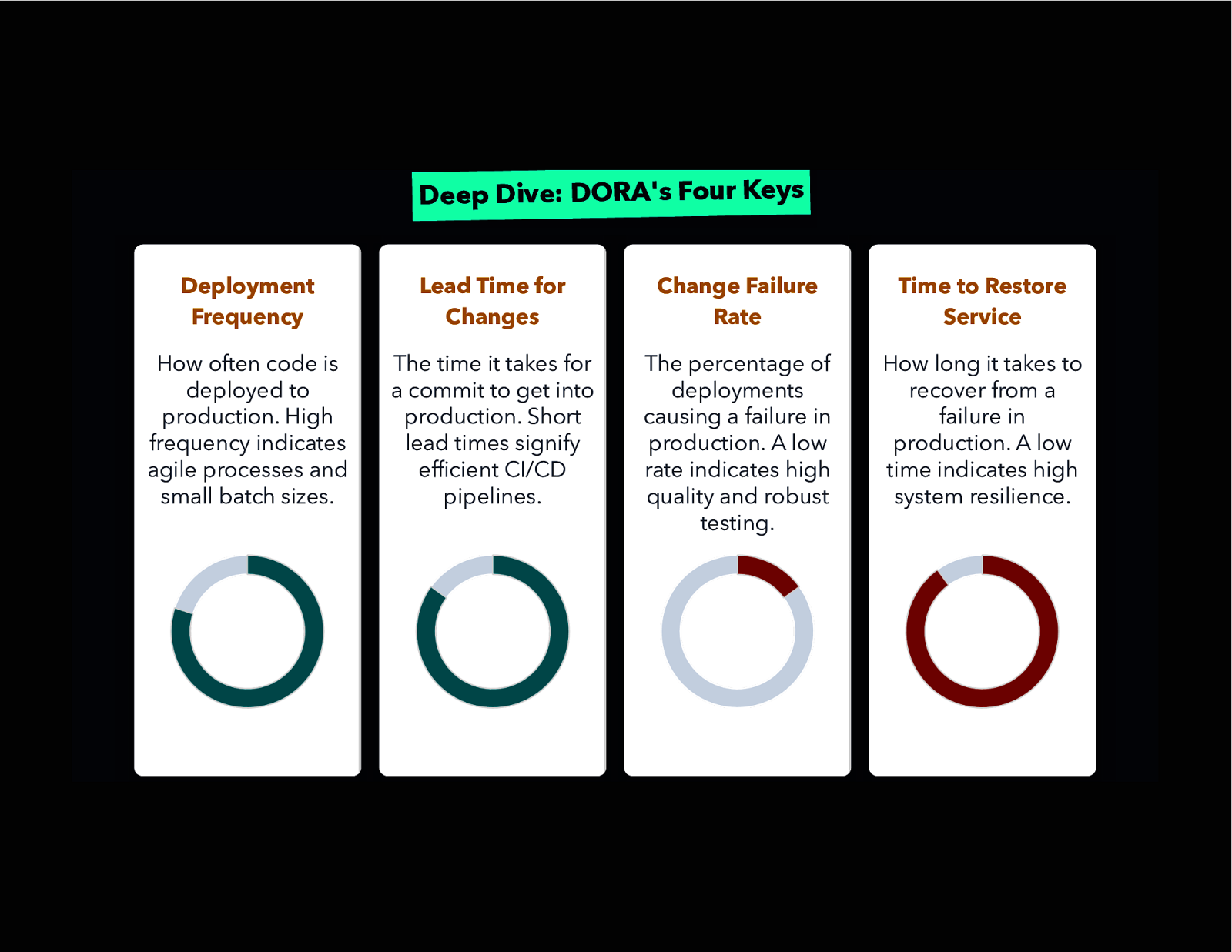
Deep Dive: DORA’s Four Keys Deployment Frequency Lead Time for Changes Change Failure Rate Time to Restore Service How often code is deployed to production. High frequency indicates agile processes and small batch sizes. The time it takes for a commit to get into production. Short lead times signify efficient CI/CD pipelines. The percentage of deployments causing a failure in production. A low rate indicates high quality and robust testing. How long it takes to recover from a failure in production. A low time indicates high system resilience.
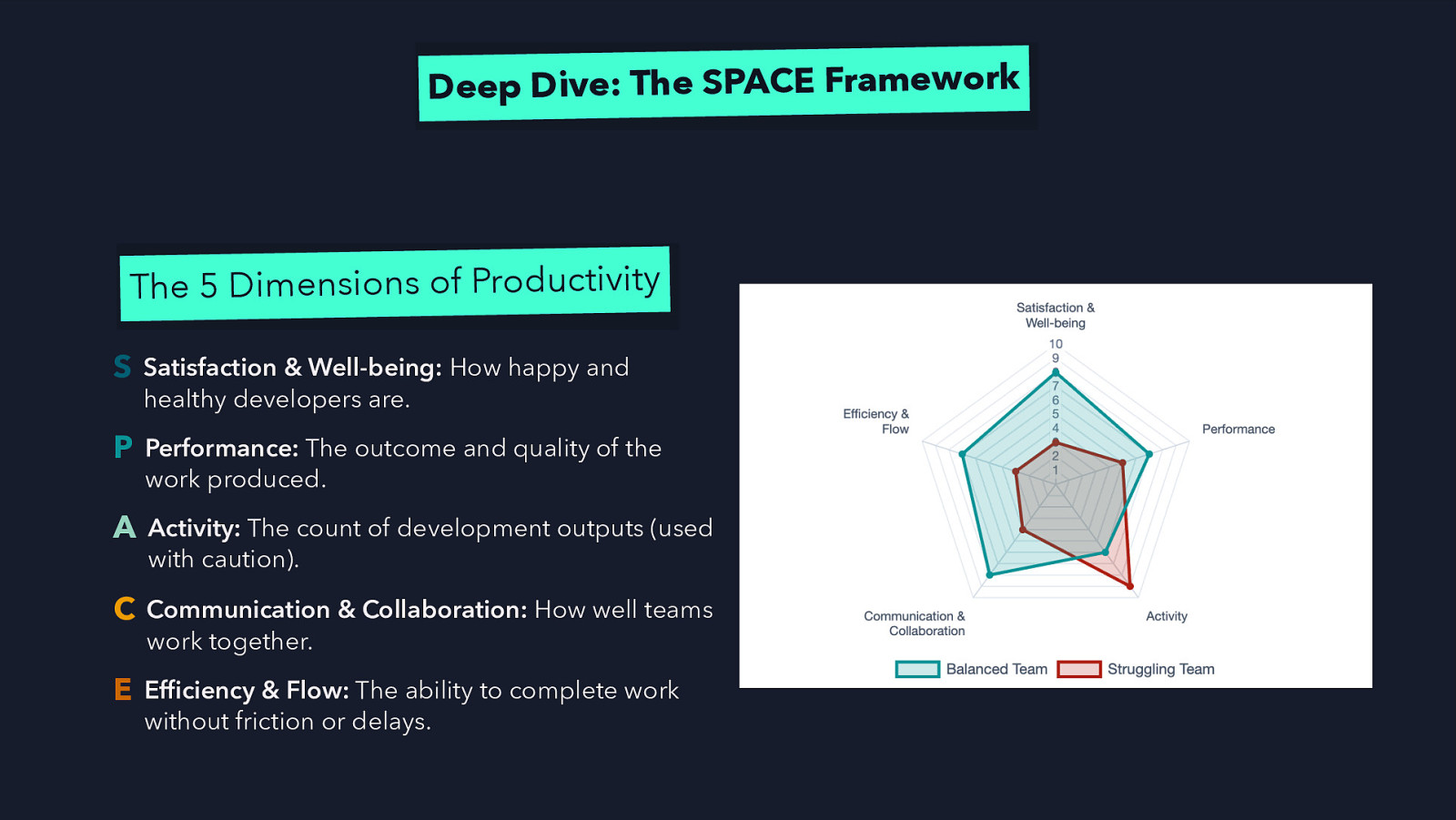
Deep Dive: The SPACE Framework The 5 Dimensions of Productivity S Satisfaction & Well-being: How happy and healthy developers are. P Performance: The outcome and quality of the work produced. A Activity: The count of development outputs (used with caution). C Communication & Collaboration: How well teams work together. E Efficiency & Flow: The ability to complete work without friction or delays.
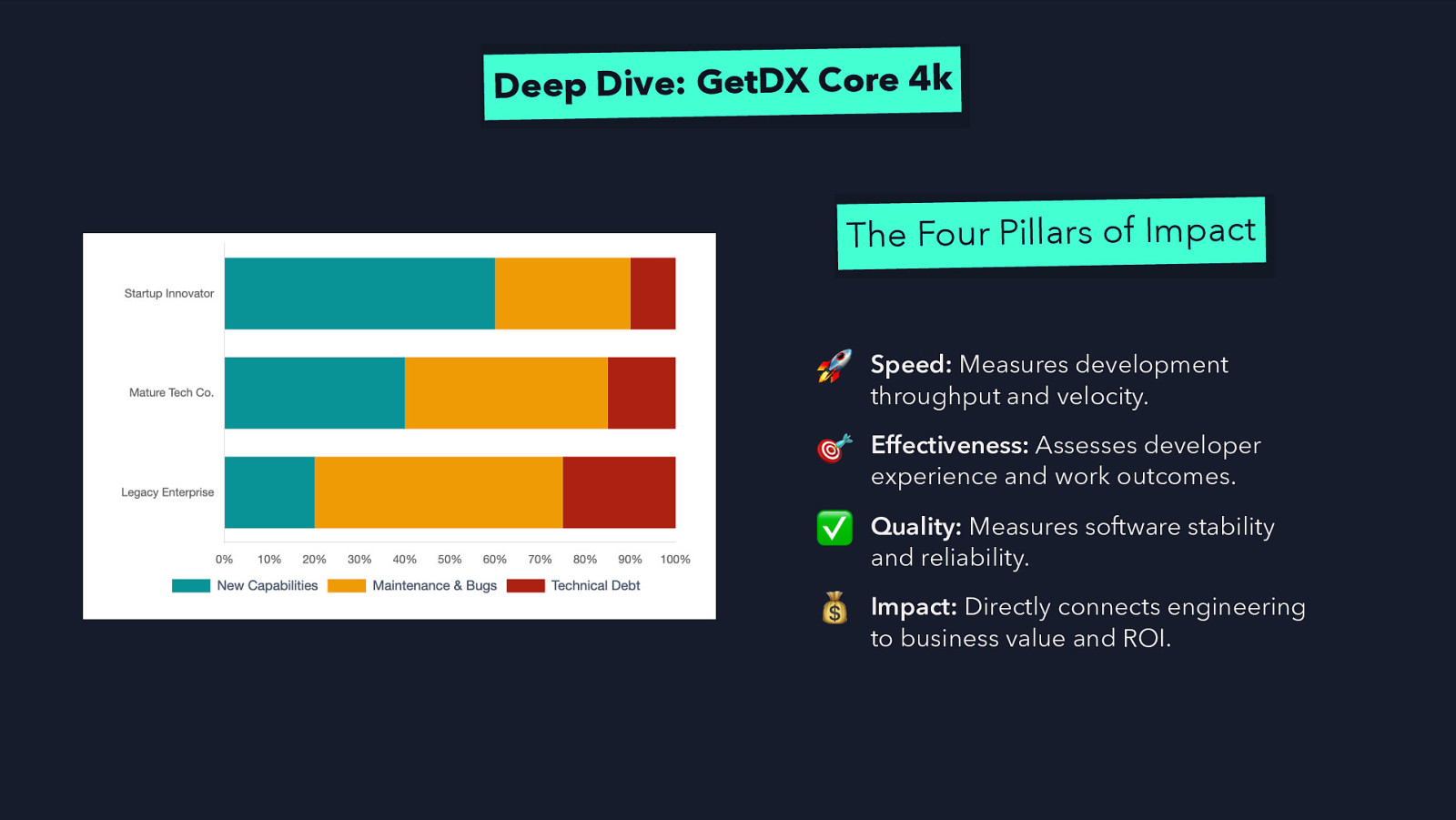
Deep Dive: GetDX Core 4k The Four Pillars of Impact Speed: Measures development throughput and velocity. Effectiveness: Assesses developer experience and work outcomes. Quality: Measures software stability and reliability. Impact: Directly connects engineering to business value and ROI.
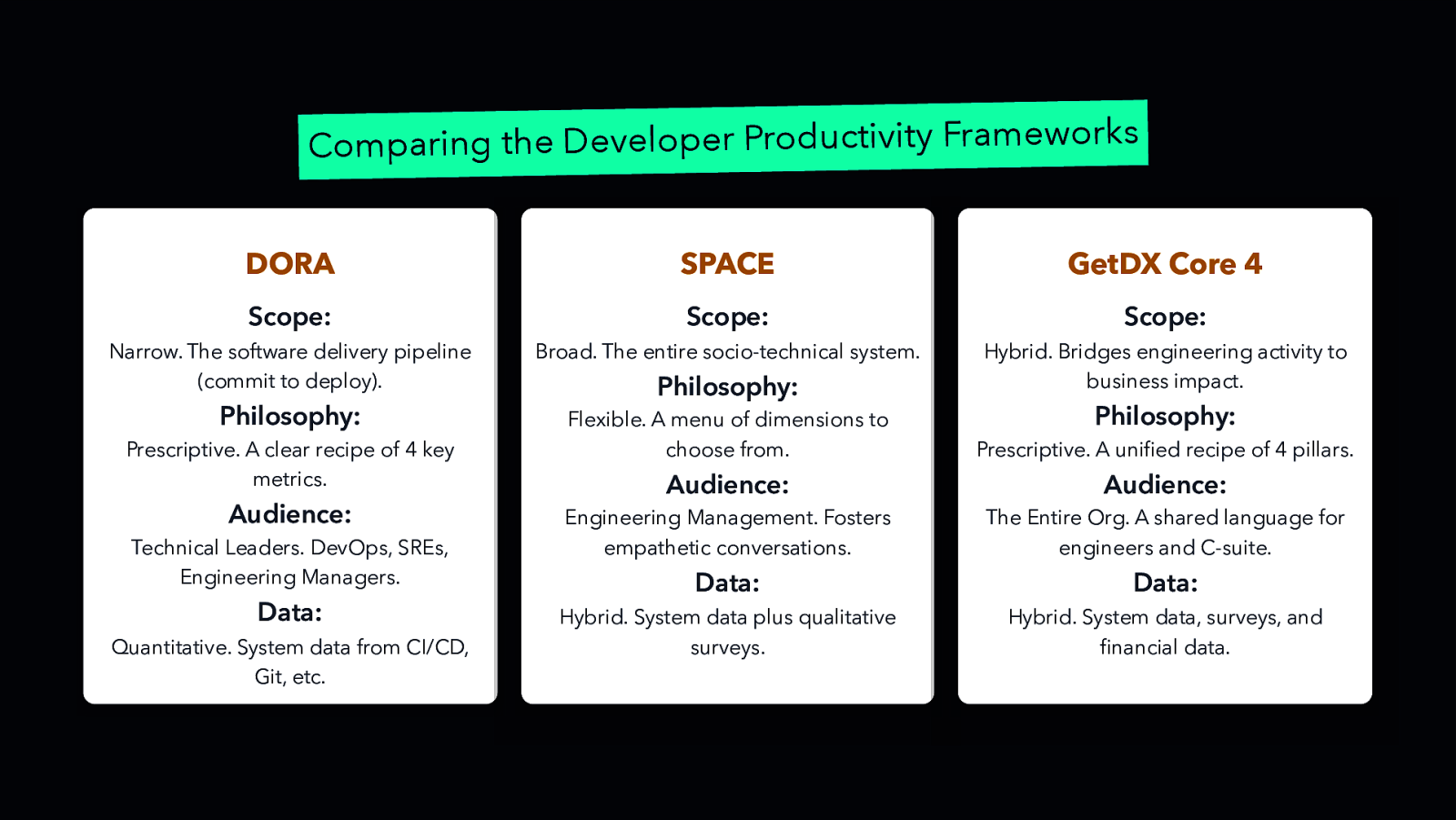
Comparing the Developer Productivity Frameworks DORA SPACE GetDX Core 4 Scope: Scope: Scope: Narrow. The software delivery pipeline (commit to deploy). Broad. The entire socio-technical system. Philosophy: Philosophy: Hybrid. Bridges engineering activity to business impact. Flexible. A menu of dimensions to choose from. Prescriptive. A unified recipe of 4 pillars. Audience: Audience: Engineering Management. Fosters empathetic conversations. The Entire Org. A shared language for engineers and C-suite. Data: Data: Hybrid. System data plus qualitative surveys. Hybrid. System data, surveys, and financial data. Prescriptive. A clear recipe of 4 key metrics. Audience: Technical Leaders. DevOps, SREs, Engineering Managers. Data: Quantitative. System data from CI/CD, Git, etc. Philosophy:
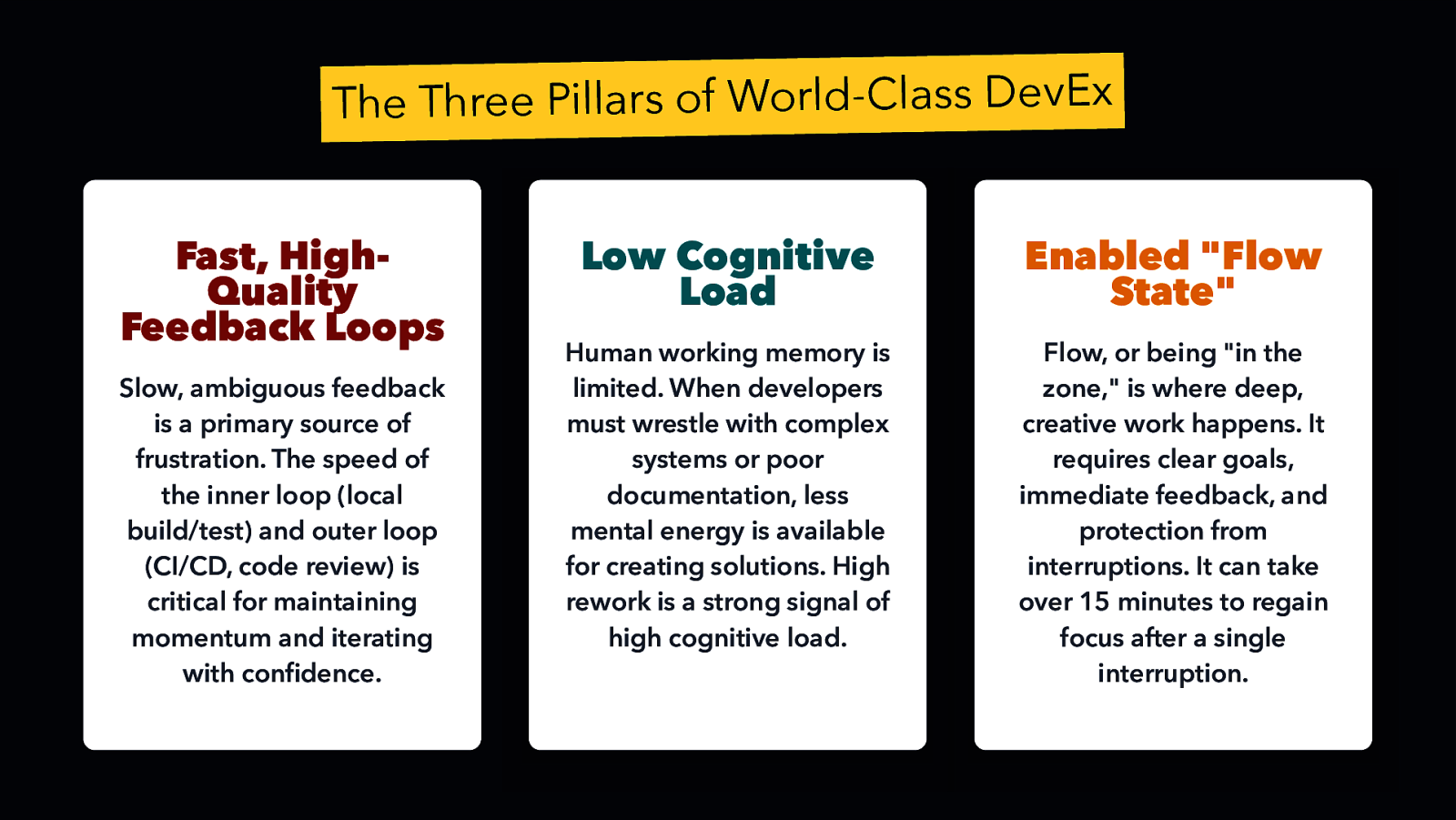
The Three Pillars of World-Class DevEx Fast, HighQuality Feedback Loops Slow, ambiguous feedback is a primary source of frustration. The speed of the inner loop (local build/test) and outer loop (CI/CD, code review) is critical for maintaining momentum and iterating with confidence. Low Cognitive Load Enabled “Flow State” Human working memory is limited. When developers must wrestle with complex systems or poor documentation, less mental energy is available for creating solutions. High rework is a strong signal of high cognitive load. Flow, or being “in the zone,” is where deep, creative work happens. It requires clear goals, immediate feedback, and protection from interruptions. It can take over 15 minutes to regain focus after a single interruption.
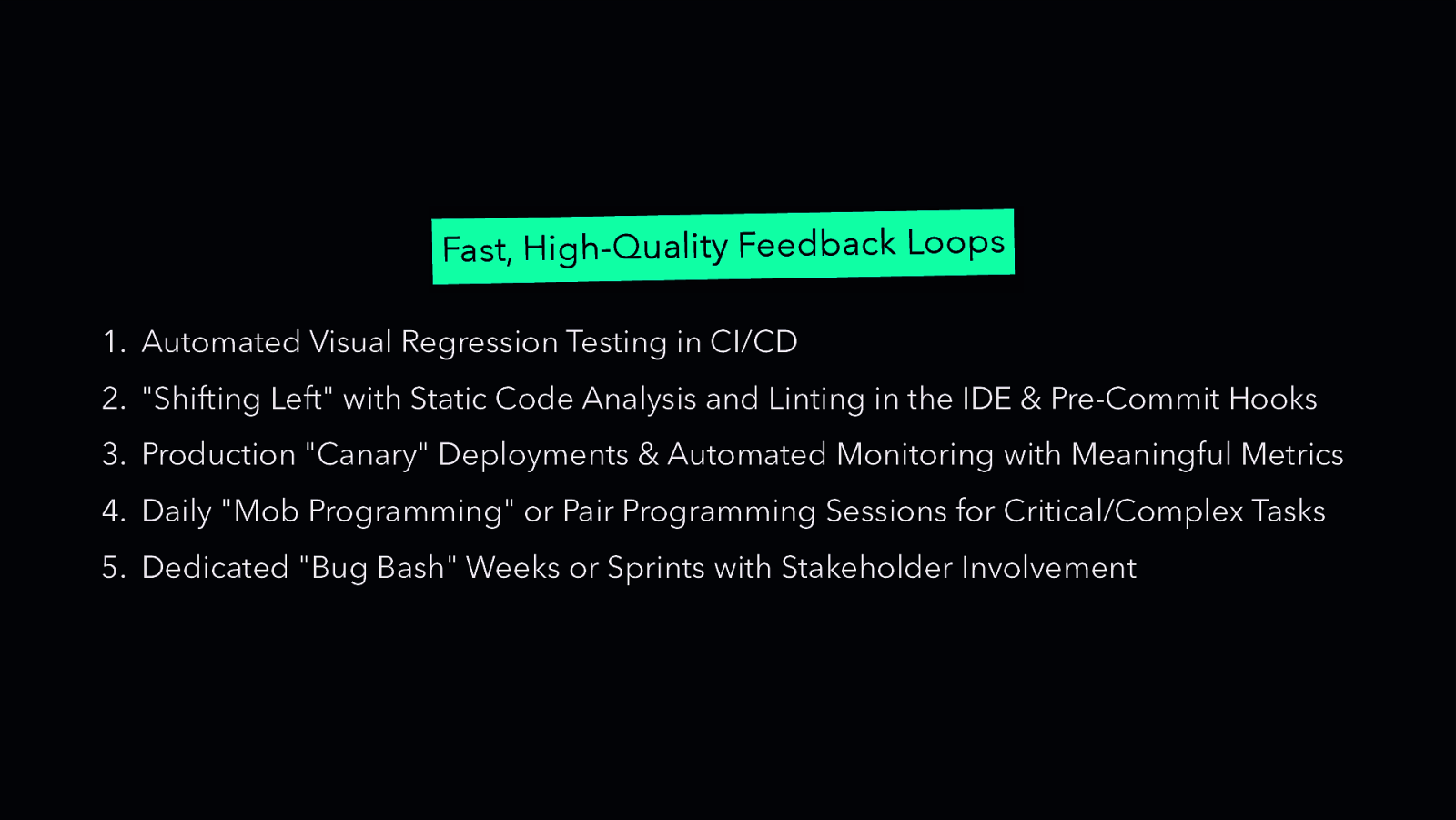
Fast, High-Quality Feedback Loops 1. Automated Visual Regression Testing in CI/CD 2. “Shifting Left” with Static Code Analysis and Linting in the IDE & Pre-Commit Hooks 3. Production “Canary” Deployments & Automated Monitoring with Meaningful Metrics 4. Daily “Mob Programming” or Pair Programming Sessions for Critical/Complex Tasks 5. Dedicated “Bug Bash” Weeks or Sprints with Stakeholder Involvement
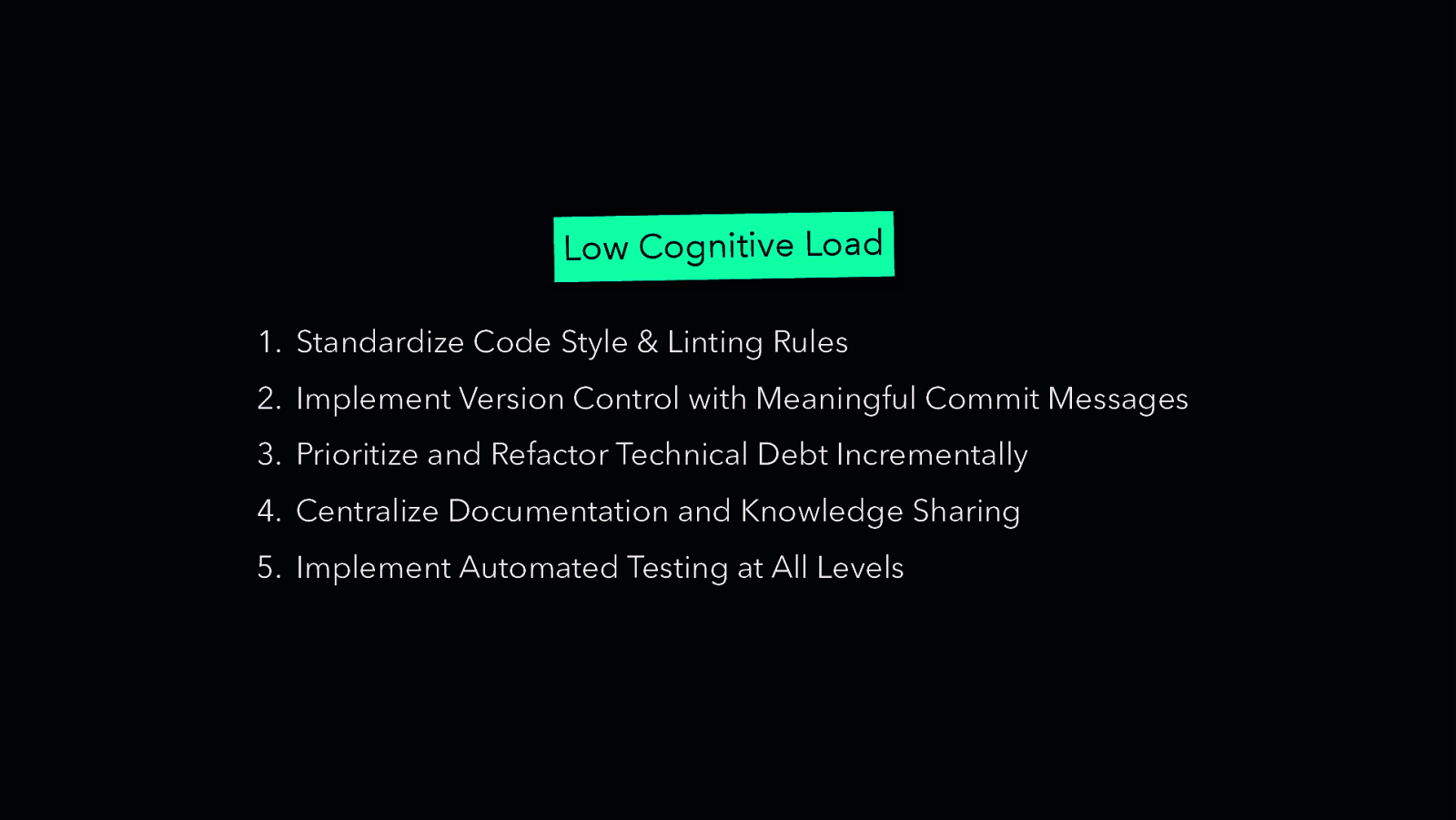
Low Cognitive Load 1. Standardize Code Style & Linting Rules 2. Implement Version Control with Meaningful Commit Messages 3. Prioritize and Refactor Technical Debt Incrementally 4. Centralize Documentation and Knowledge Sharing 5. Implement Automated Testing at All Levels
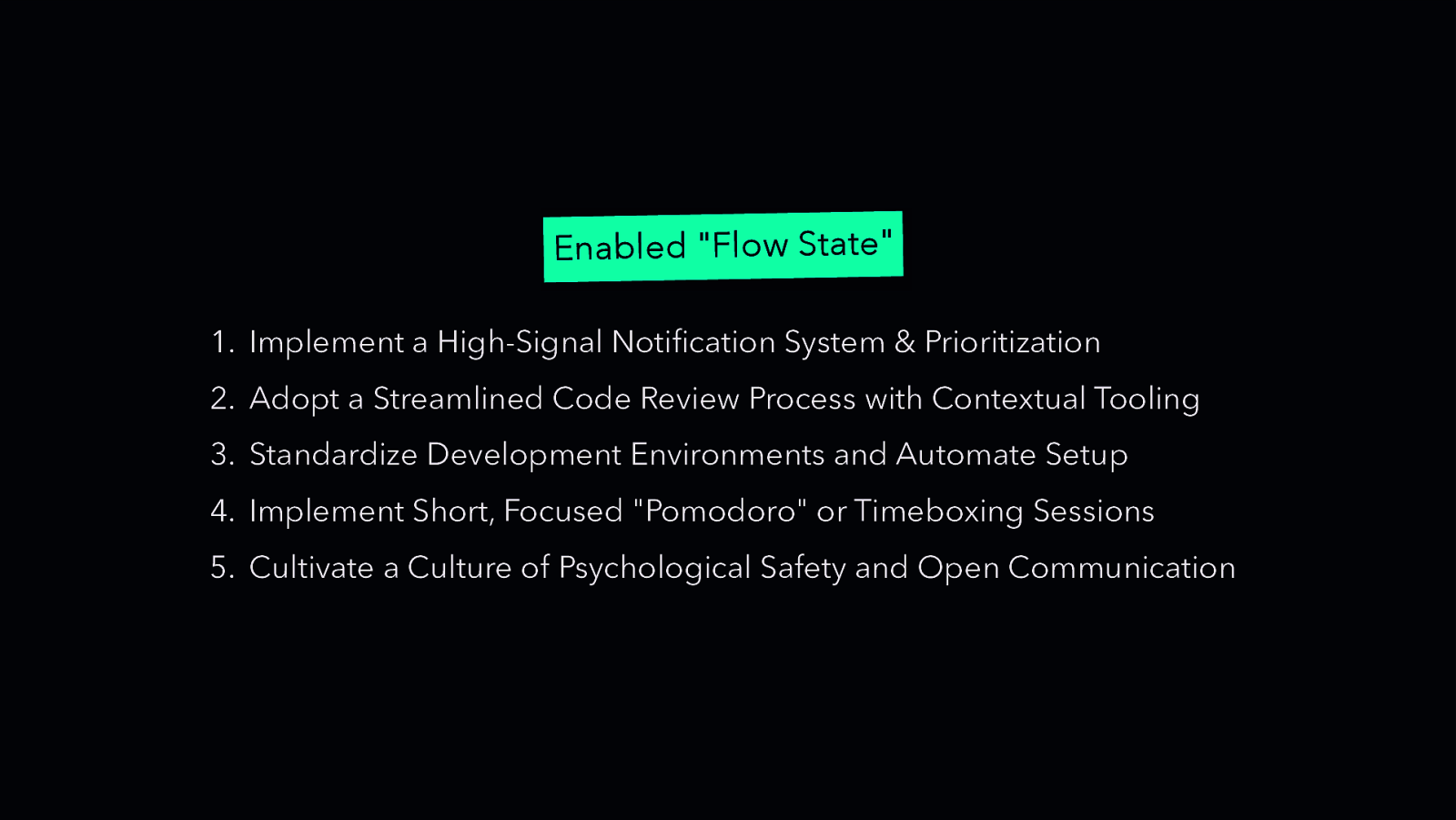
Enabled “Flow State” 1. Implement a High-Signal Notification System & Prioritization 2. Adopt a Streamlined Code Review Process with Contextual Tooling 3. Standardize Development Environments and Automate Setup 4. Implement Short, Focused “Pomodoro” or Timeboxing Sessions 5. Cultivate a Culture of Psychological Safety and Open Communication
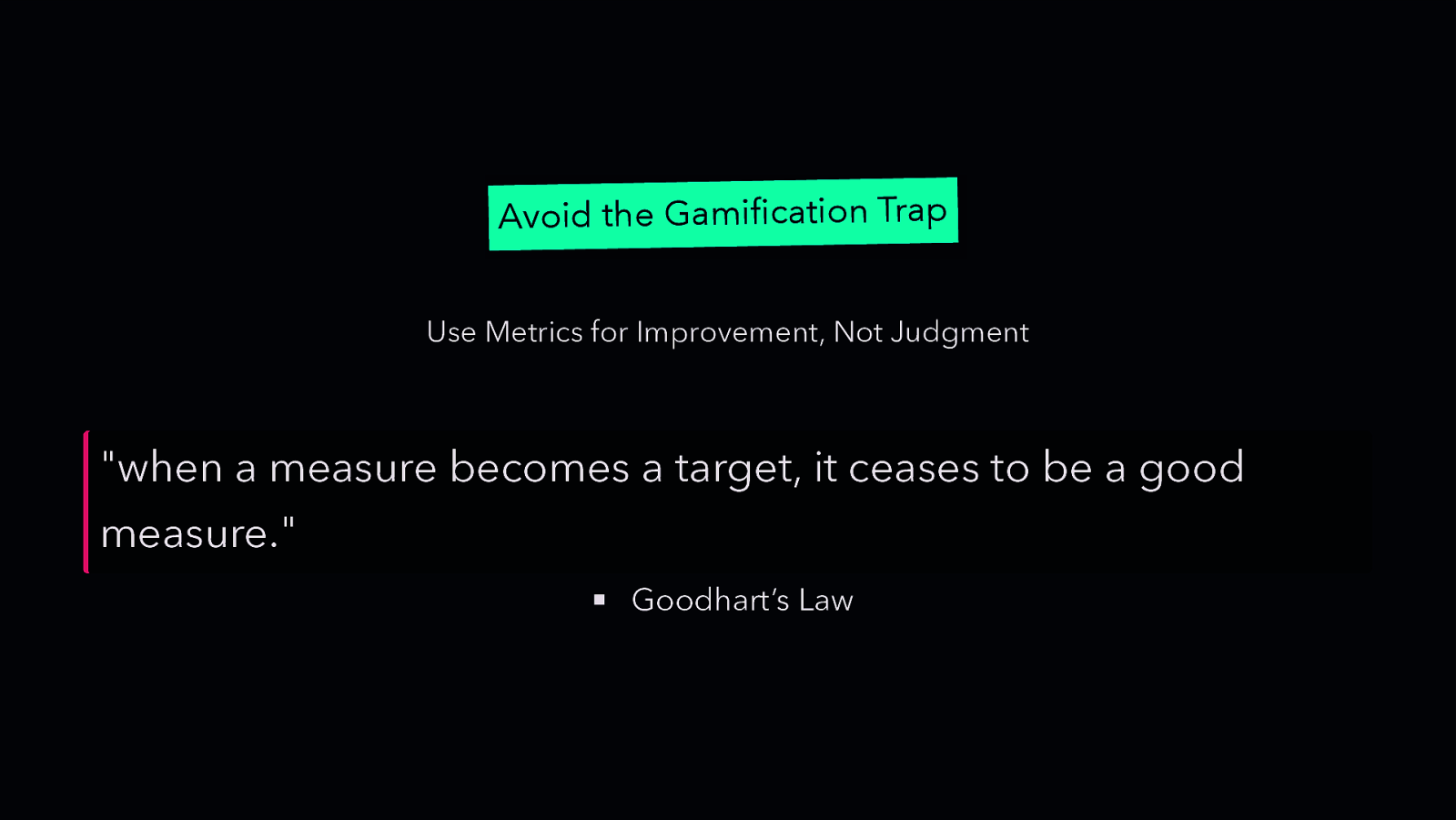
Avoid the Gamification Trap Use Metrics for Improvement, Not Judgment “when a measure becomes a target, it ceases to be a good measure.” Goodhart’s Law
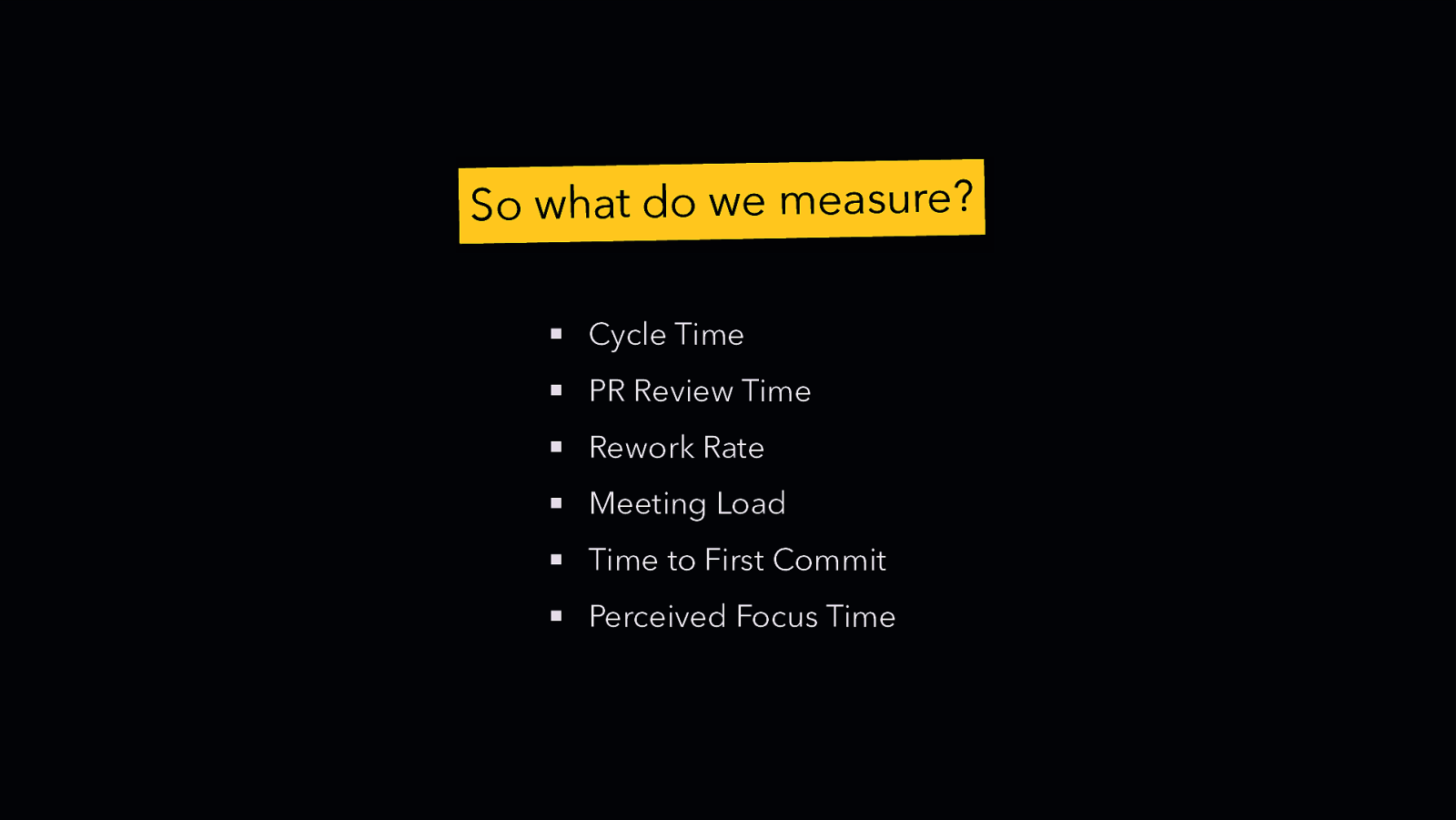
So what do we measure? Cycle Time PR Review Time Rework Rate Meeting Load Time to First Commit Perceived Focus Time
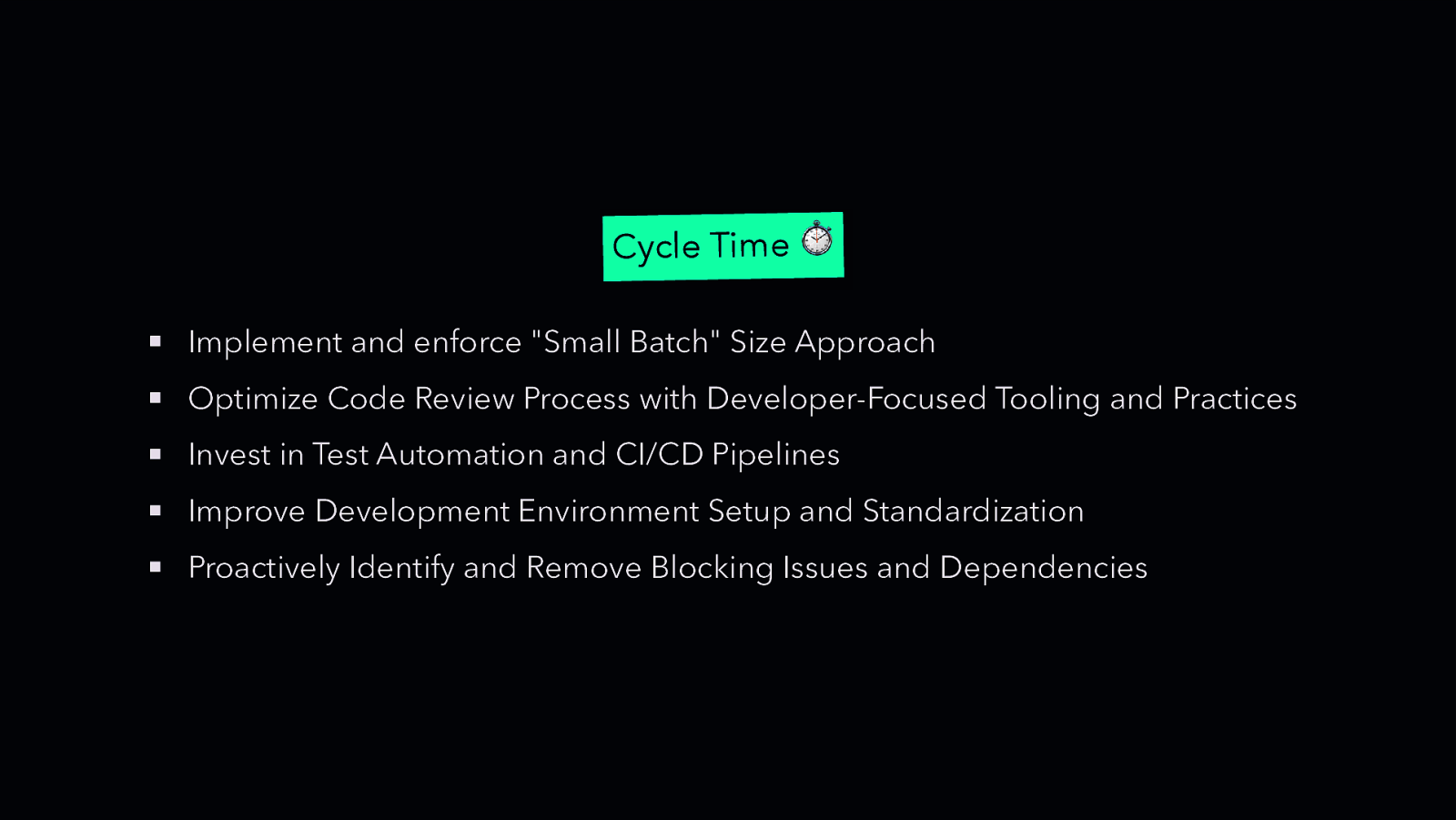
Cycle Time Implement and enforce “Small Batch” Size Approach Optimize Code Review Process with Developer-Focused Tooling and Practices Invest in Test Automation and CI/CD Pipelines Improve Development Environment Setup and Standardization Proactively Identify and Remove Blocking Issues and Dependencies
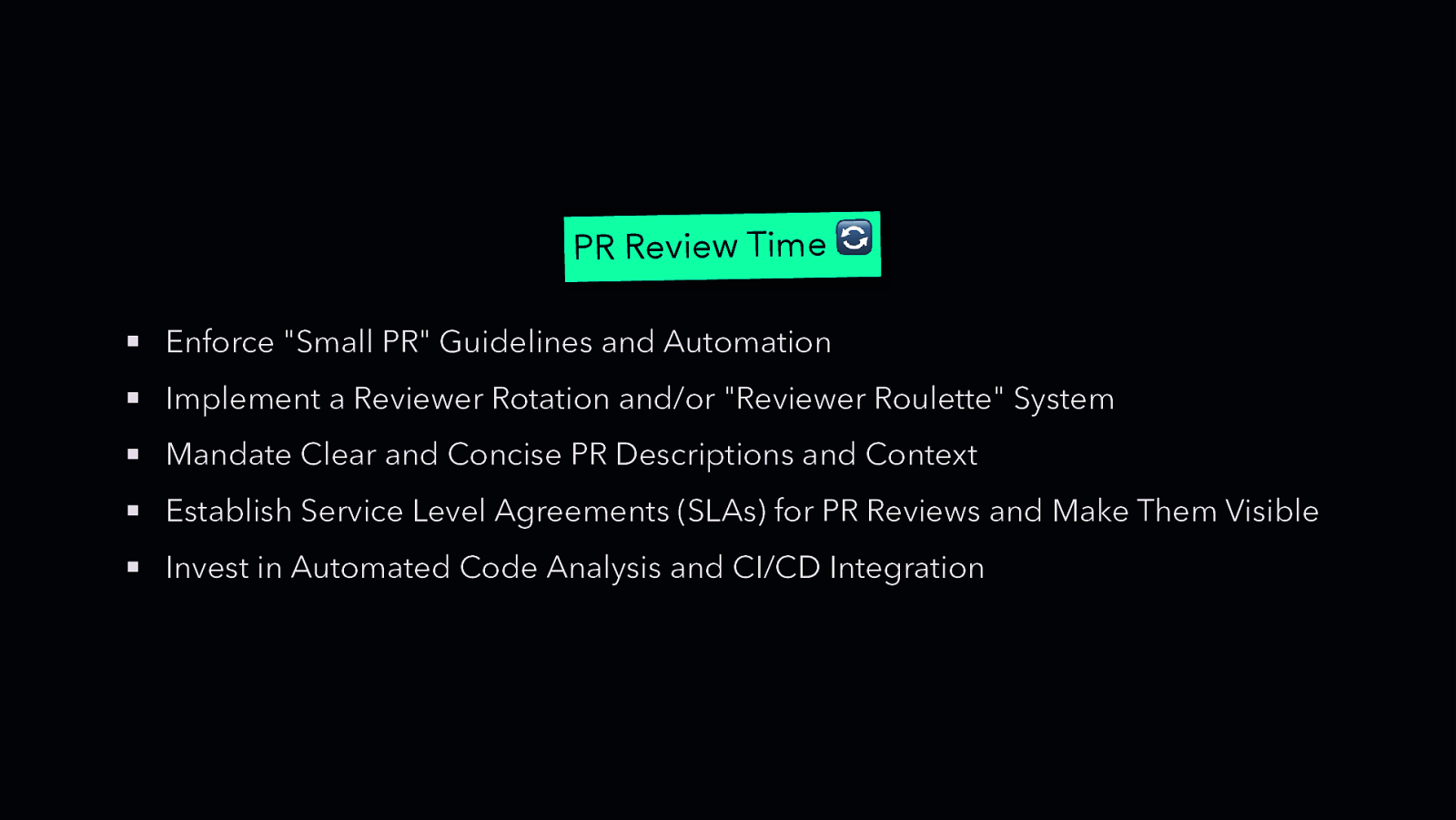
PR Review Time Enforce “Small PR” Guidelines and Automation Implement a Reviewer Rotation and/or “Reviewer Roulette” System Mandate Clear and Concise PR Descriptions and Context Establish Service Level Agreements (SLAs) for PR Reviews and Make Them Visible Invest in Automated Code Analysis and CI/CD Integration
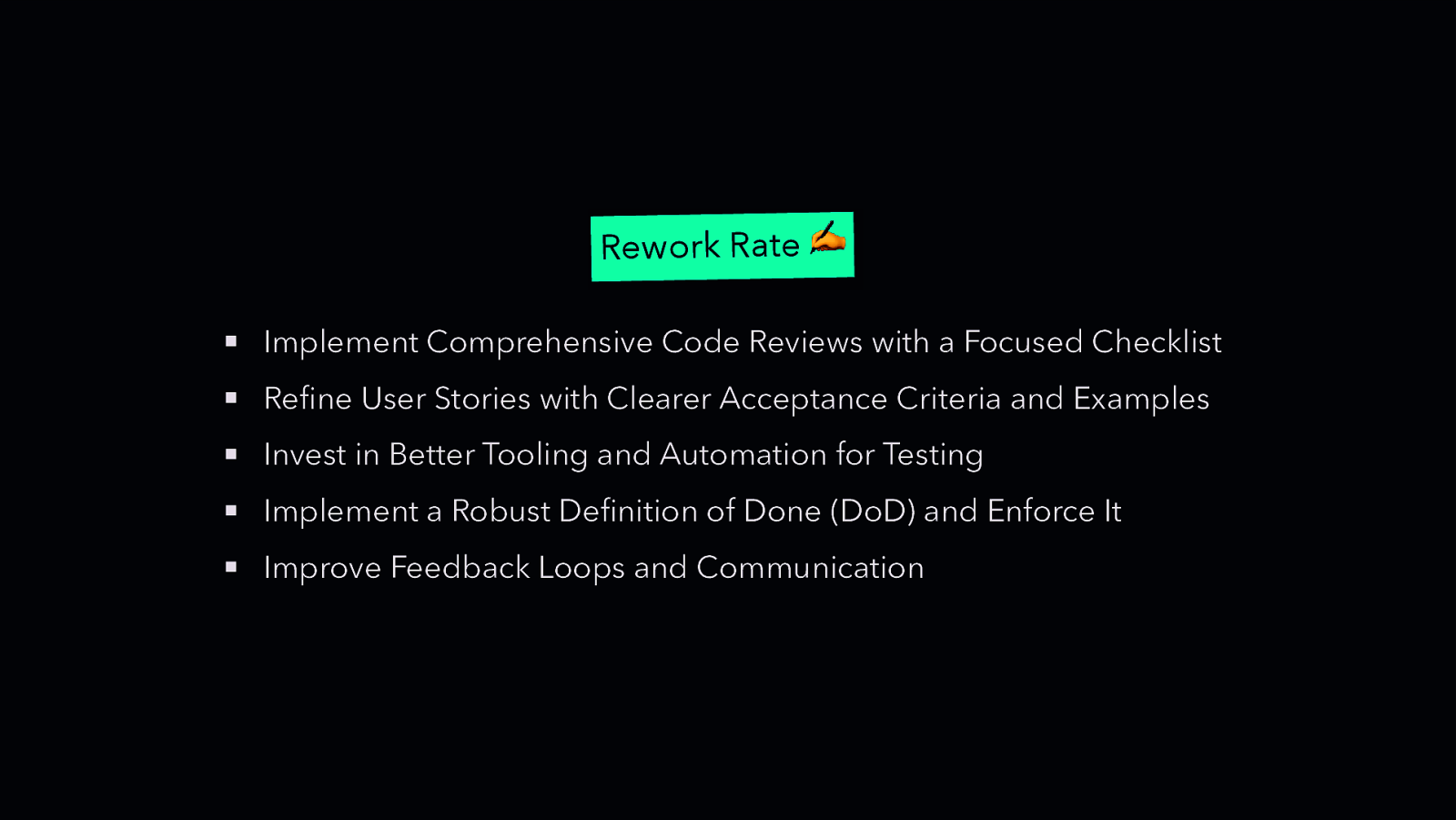
Rework Rate Implement Comprehensive Code Reviews with a Focused Checklist Refine User Stories with Clearer Acceptance Criteria and Examples Invest in Better Tooling and Automation for Testing Implement a Robust Definition of Done (DoD) and Enforce It Improve Feedback Loops and Communication
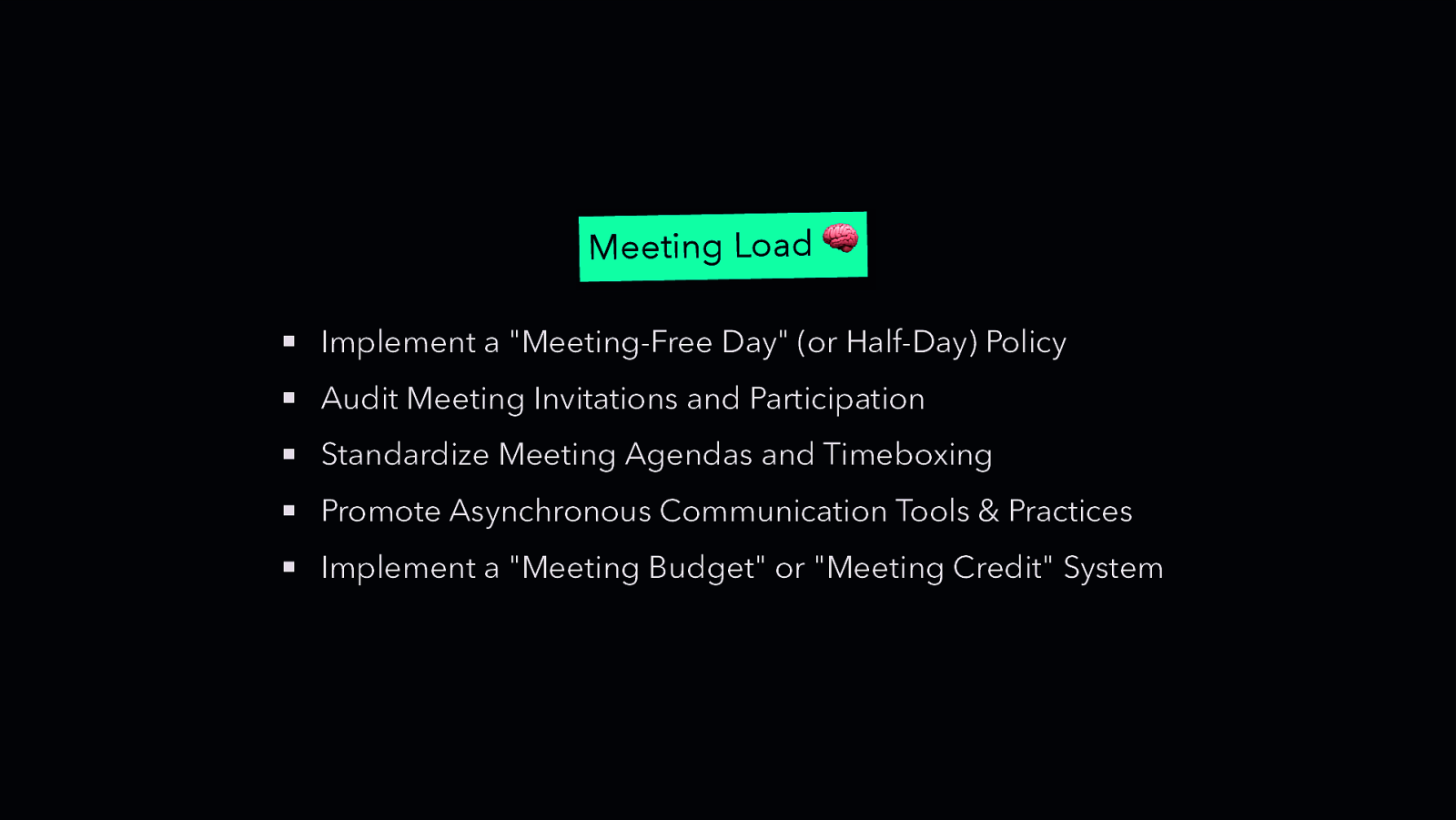
Meeting Load Implement a “Meeting-Free Day” (or Half-Day) Policy Audit Meeting Invitations and Participation Standardize Meeting Agendas and Timeboxing Promote Asynchronous Communication Tools & Practices Implement a “Meeting Budget” or “Meeting Credit” System
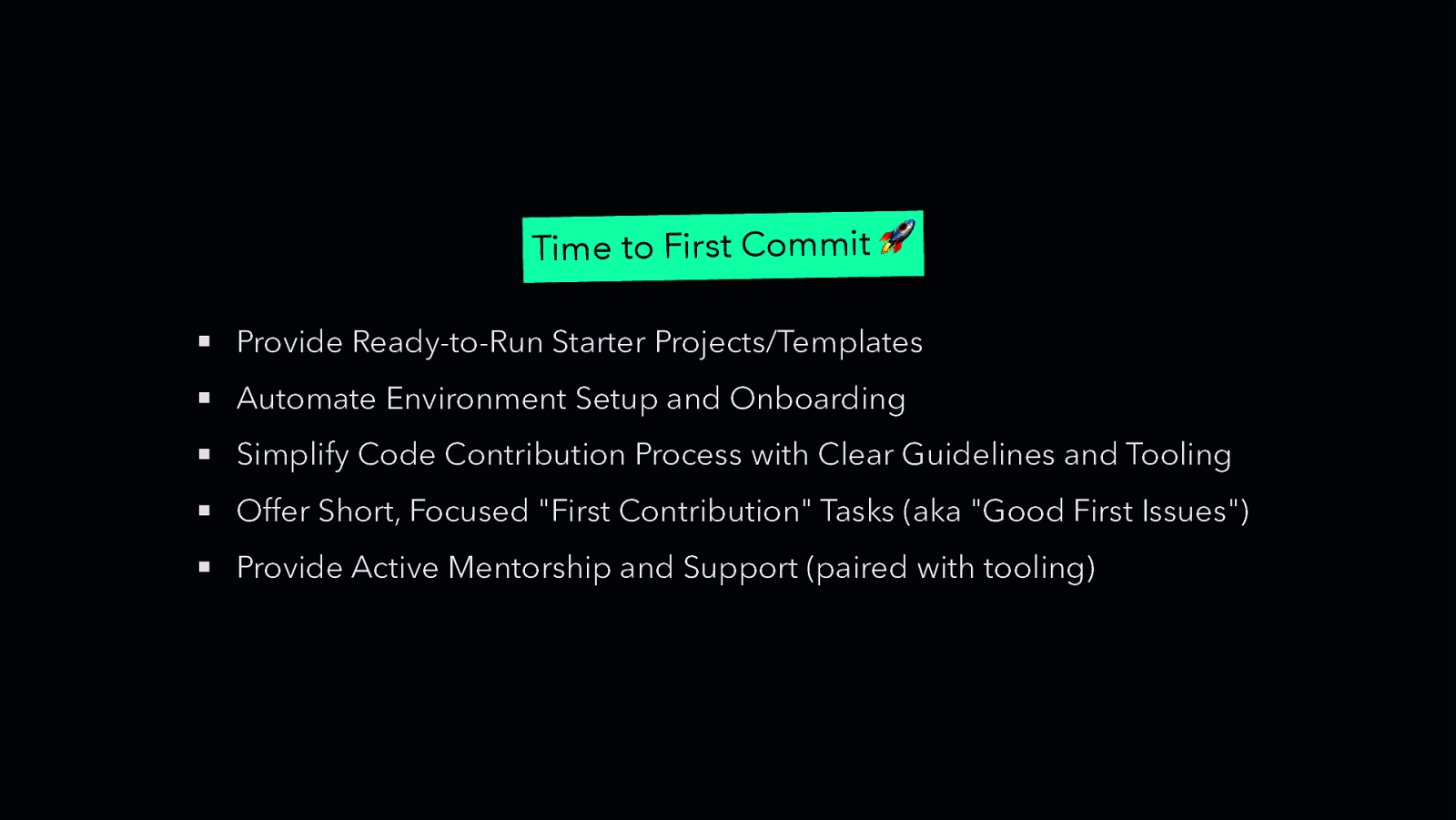
Time to First Commit Provide Ready-to-Run Starter Projects/Templates Automate Environment Setup and Onboarding Simplify Code Contribution Process with Clear Guidelines and Tooling Offer Short, Focused “First Contribution” Tasks (aka “Good First Issues”) Provide Active Mentorship and Support (paired with tooling)
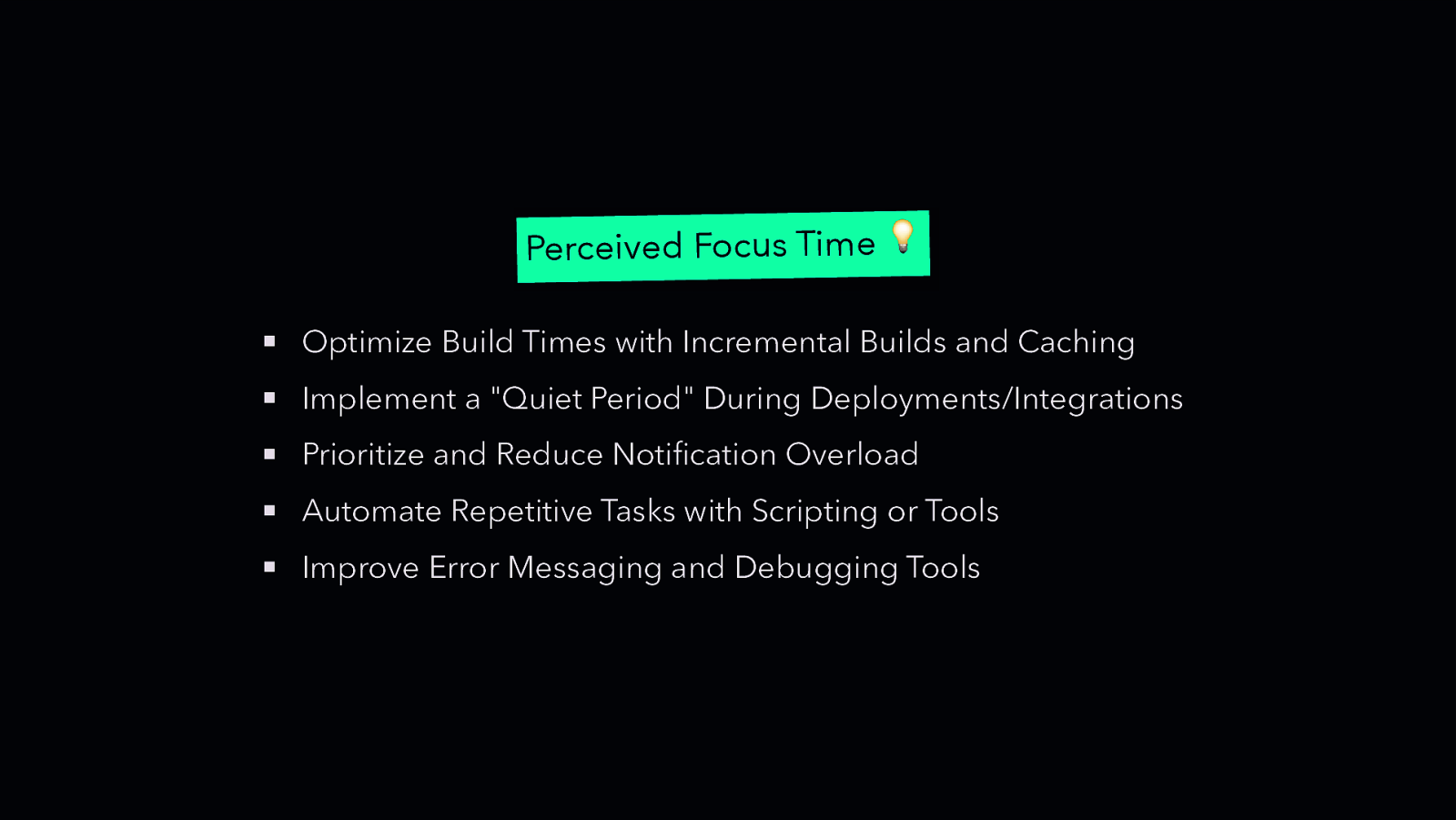
Perceived Focus Time Optimize Build Times with Incremental Builds and Caching Implement a “Quiet Period” During Deployments/Integrations Prioritize and Reduce Notification Overload Automate Repetitive Tasks with Scripting or Tools Improve Error Messaging and Debugging Tools

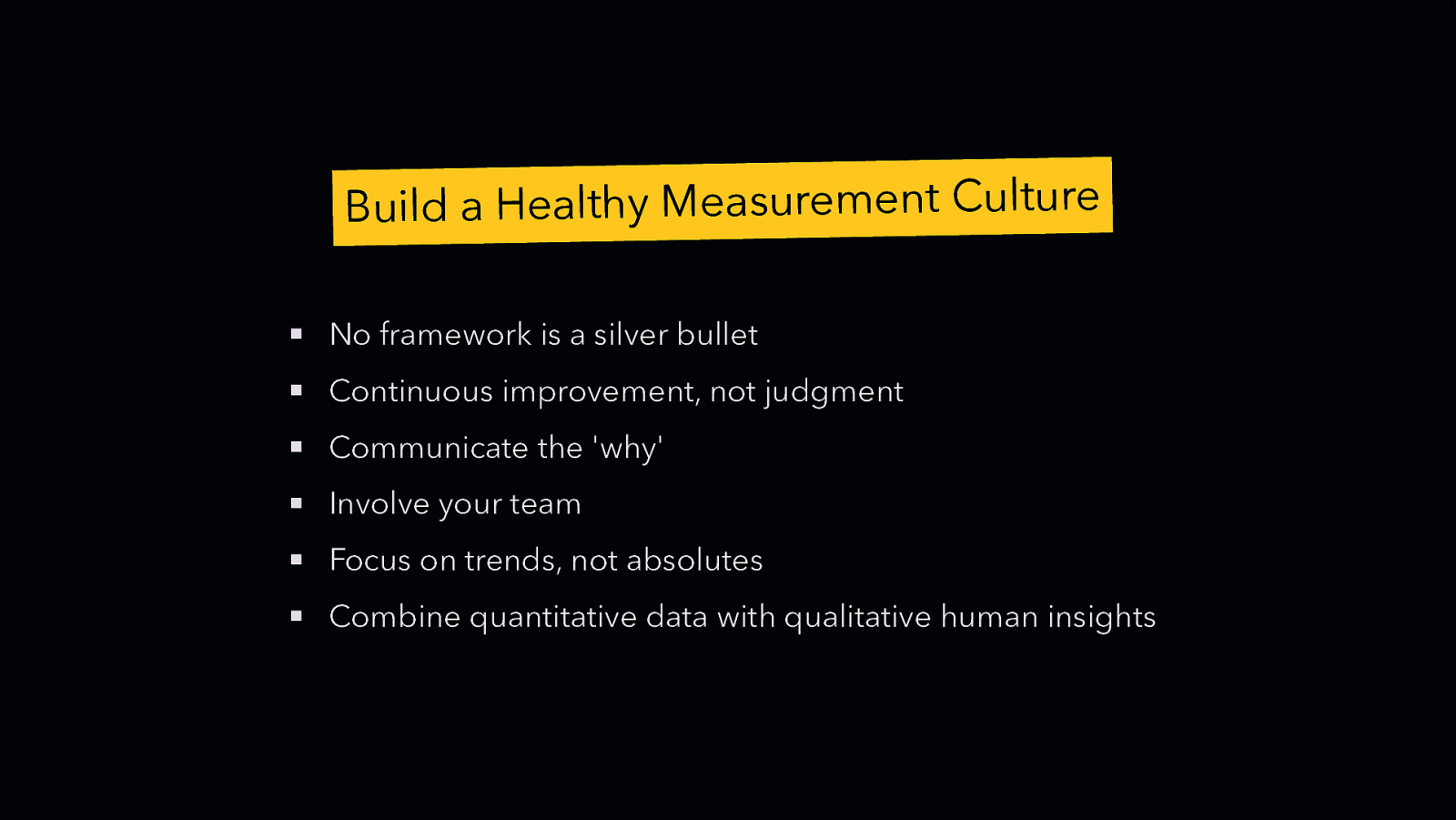
Build a Healthy Measurement Culture No framework is a silver bullet Continuous improvement, not judgment Communicate the ‘why’ Involve your team Focus on trends, not absolutes Combine quantitative data with qualitative human insights
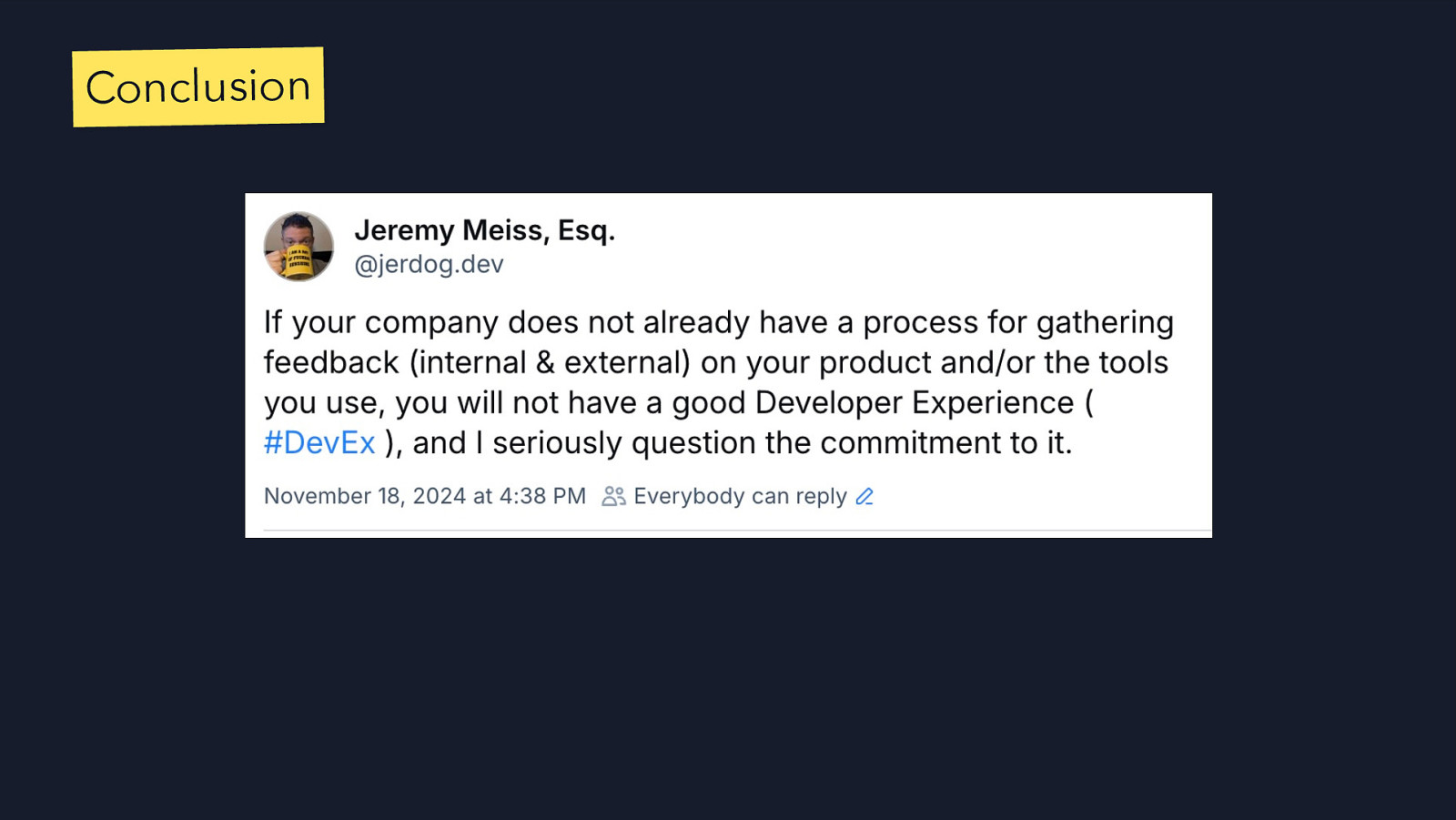
Conclusion
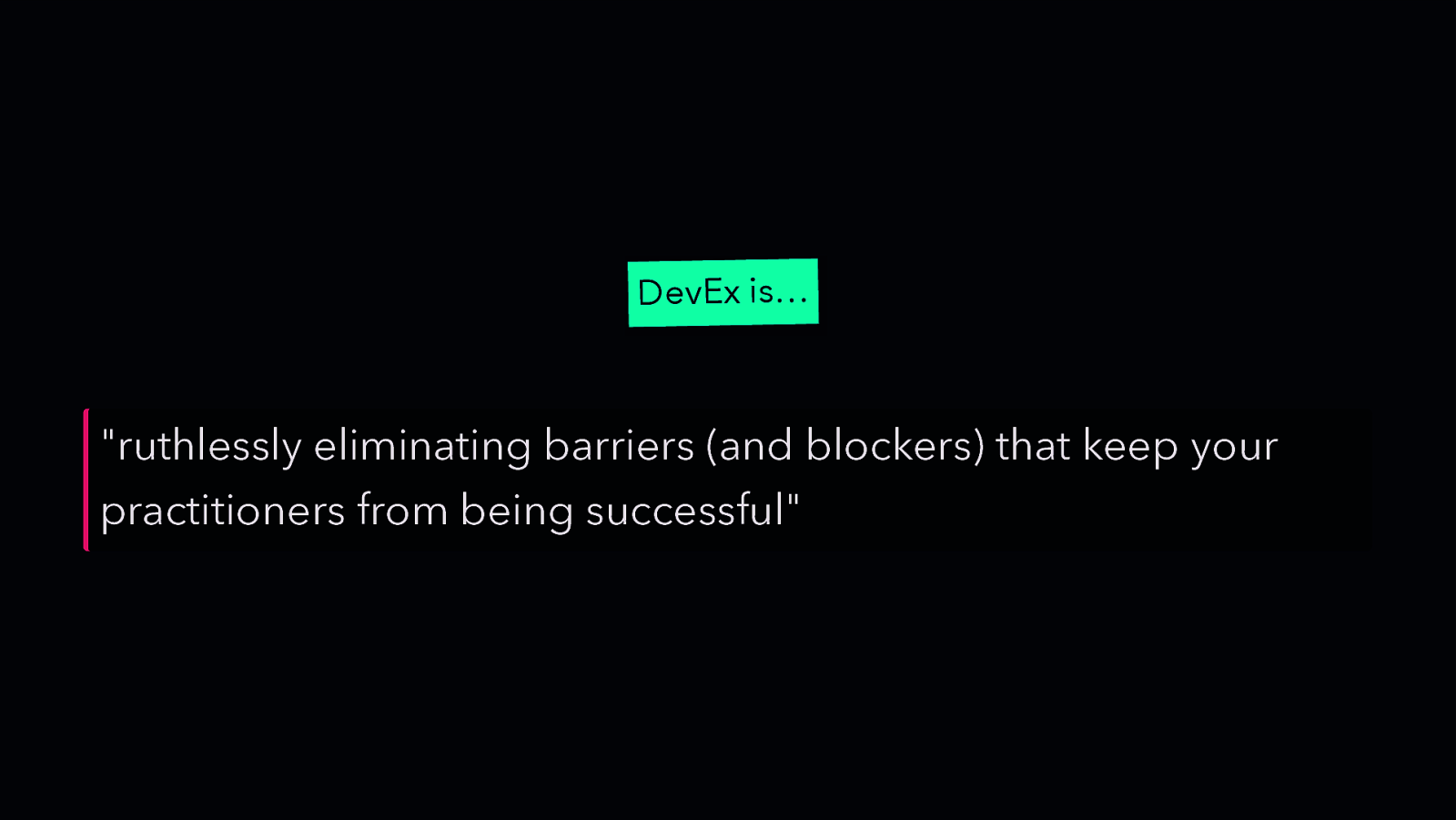
DevEx is… “ruthlessly eliminating barriers (and blockers) that keep your practitioners from being successful”
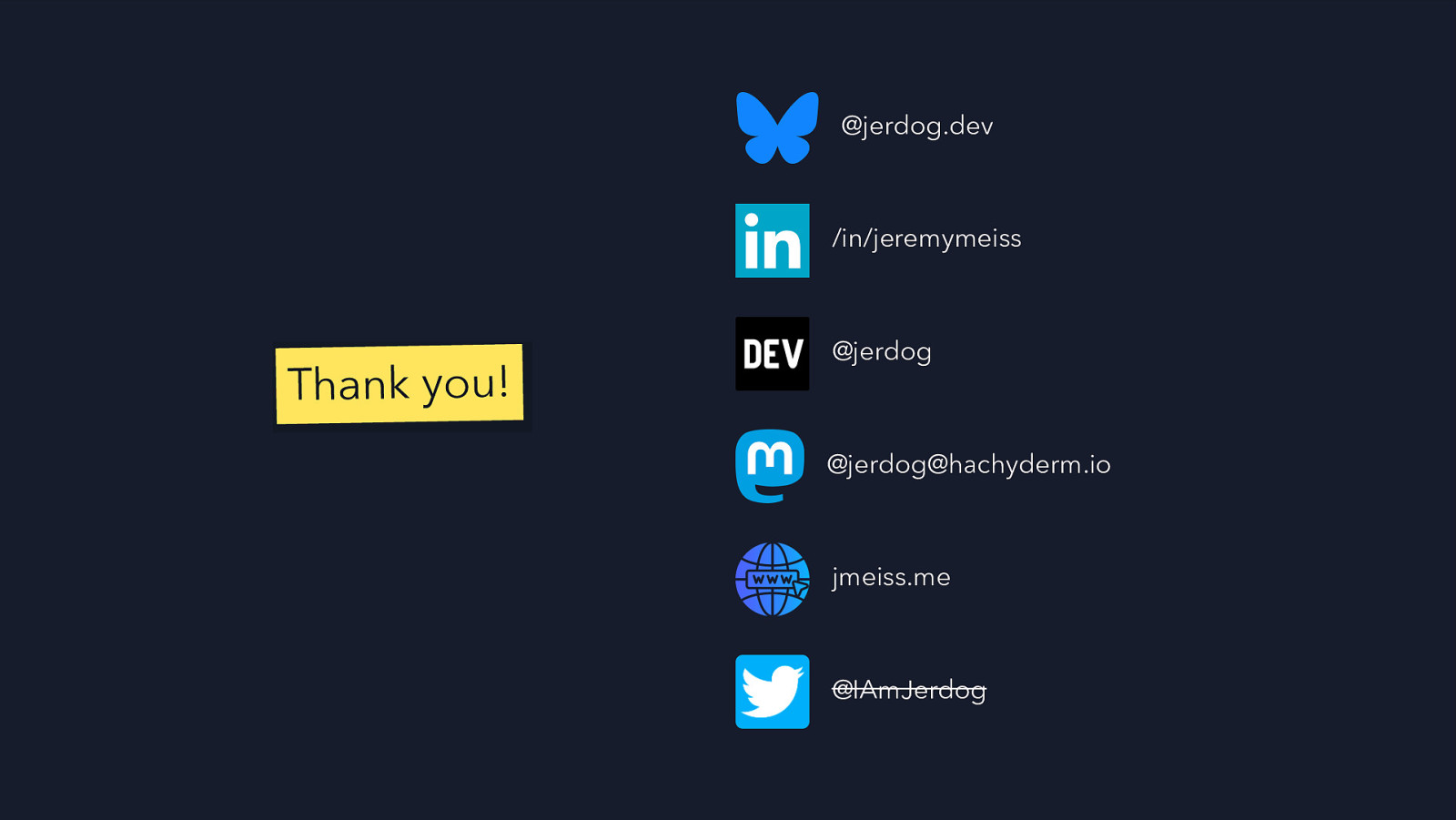
@jerdog.dev /in/jeremymeiss Thank you! @jerdog @jerdog@hachyderm.io jmeiss.me @IAmJerdog

END
With everything changing in tech at a frenetic pace, the emphasis on developer productivity has overshadowed the true essence of developer experience (DevEx). While frameworks like SPACE, getDX, and DORA metrics provide valuable insights, they often miss the mark on capturing developers’ real, day-to-day experiences using tools and services, instead focusing strictly on the bottom line for the company. Meanwhile, developers and practitioners are job-hopping more than ever.
This talk explores the origins and evolution of “developer experience,” dissect popular frameworks, and advocate for a more balanced approach that values the practitioner’s perspective. At the end we will set a path towards integrating top-down metrics with bottom-up feedback, ensuring an approach to developer experience that fosters innovation and satisfaction.
